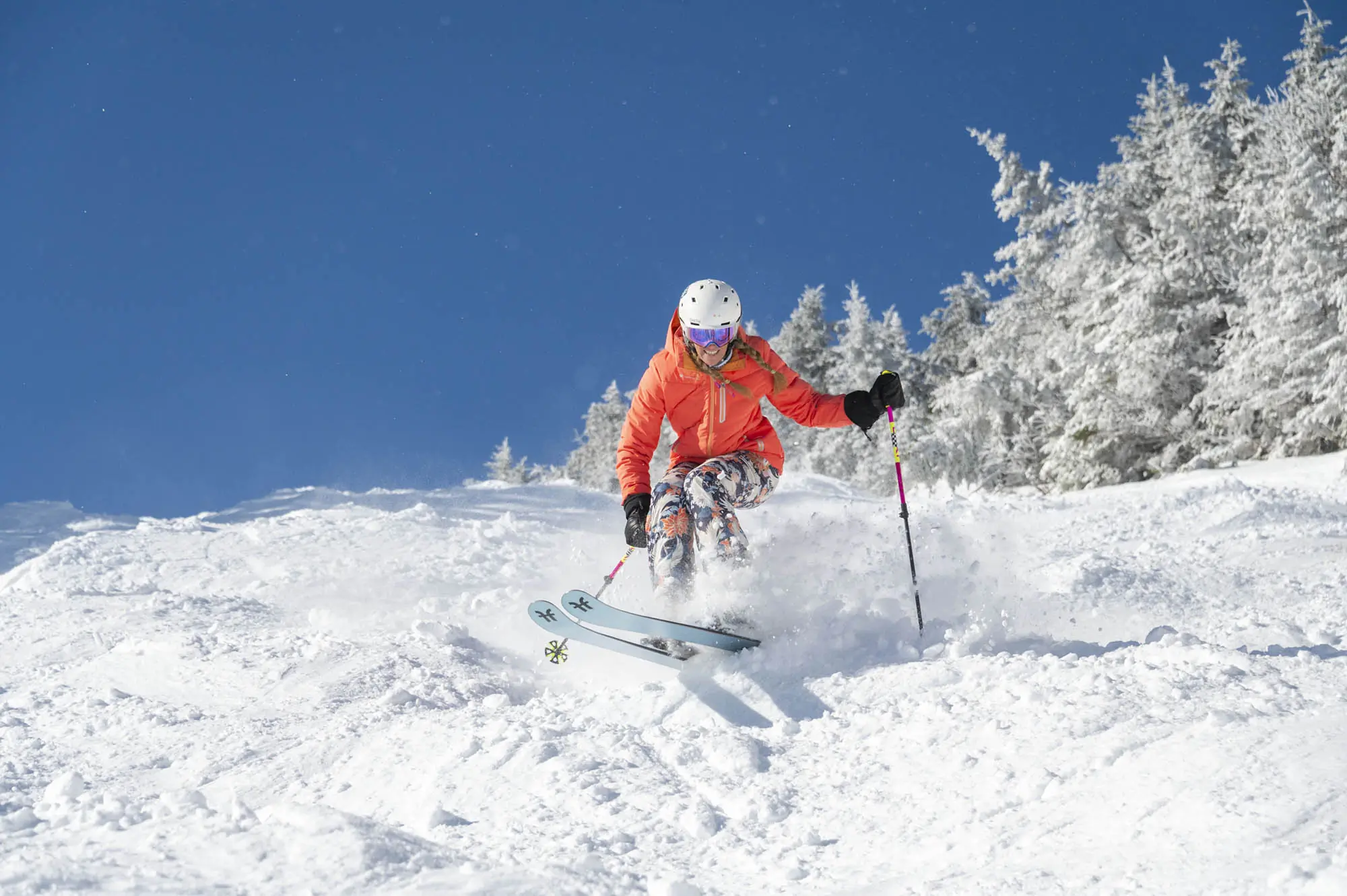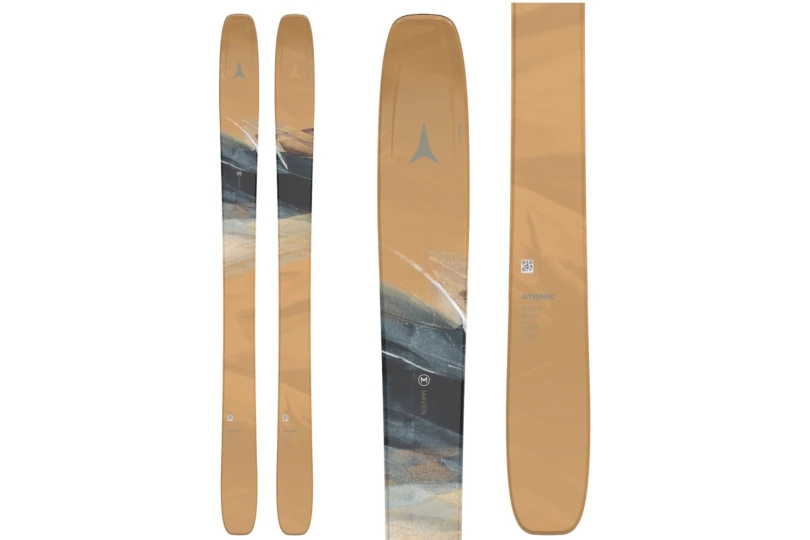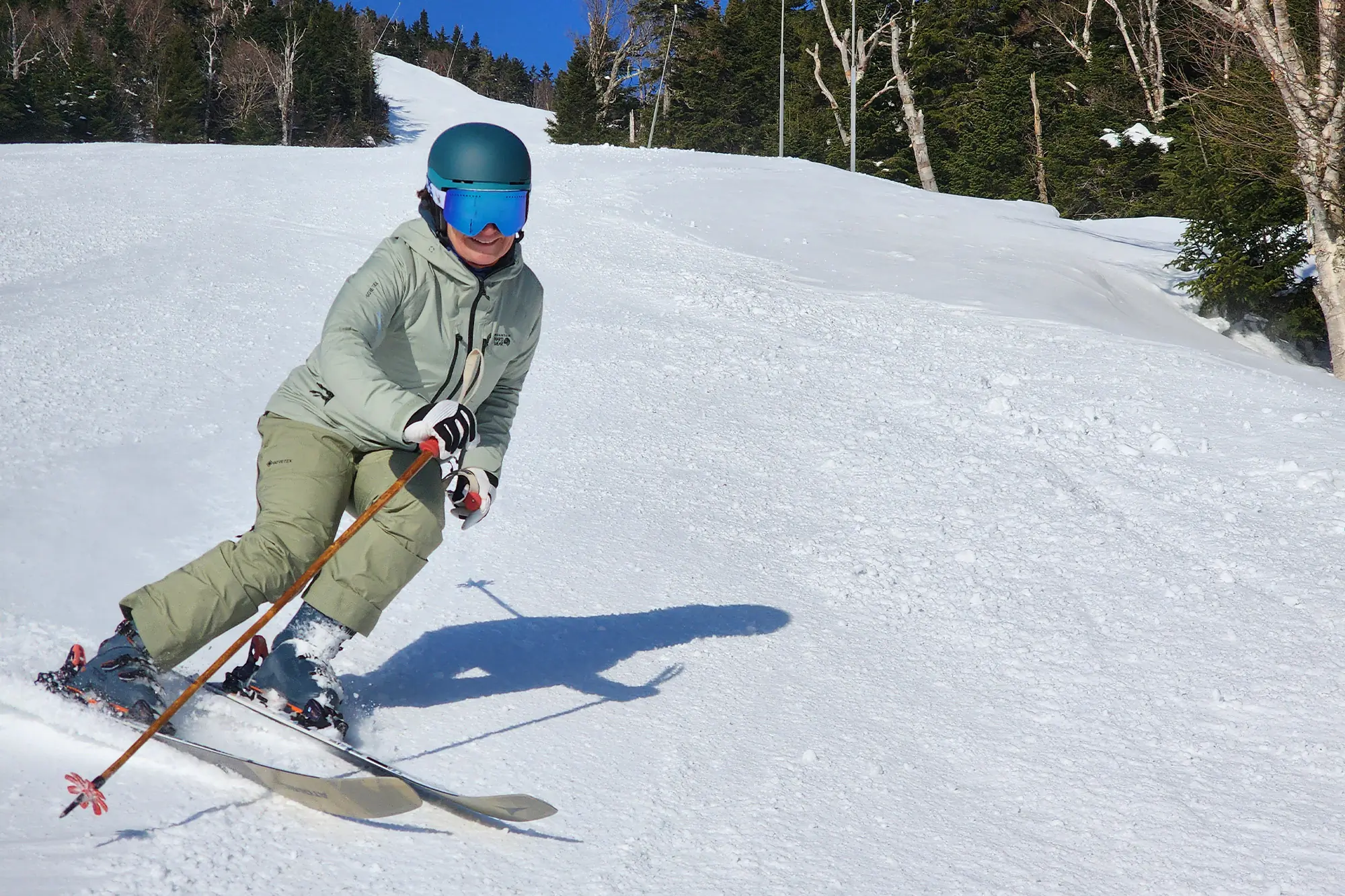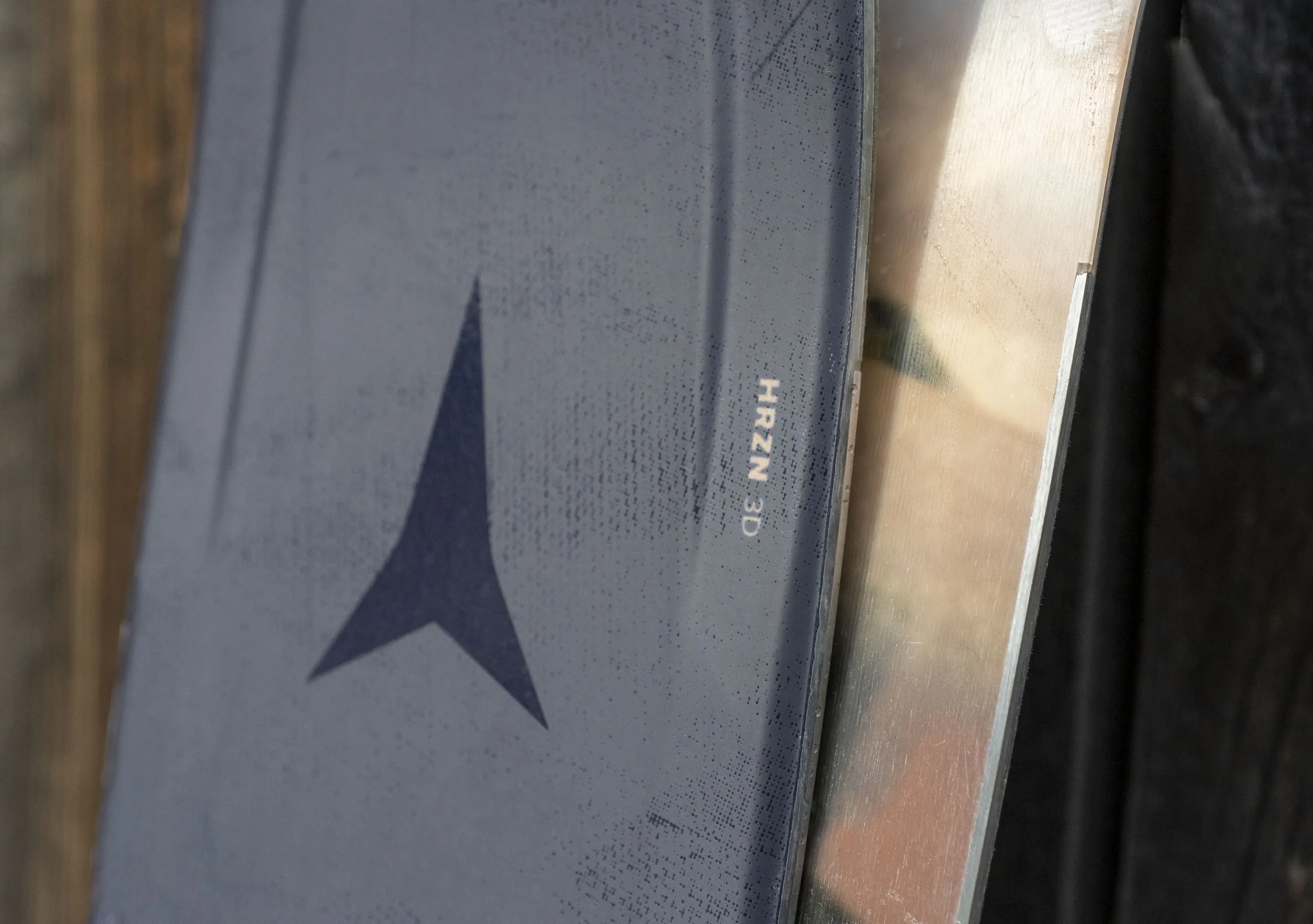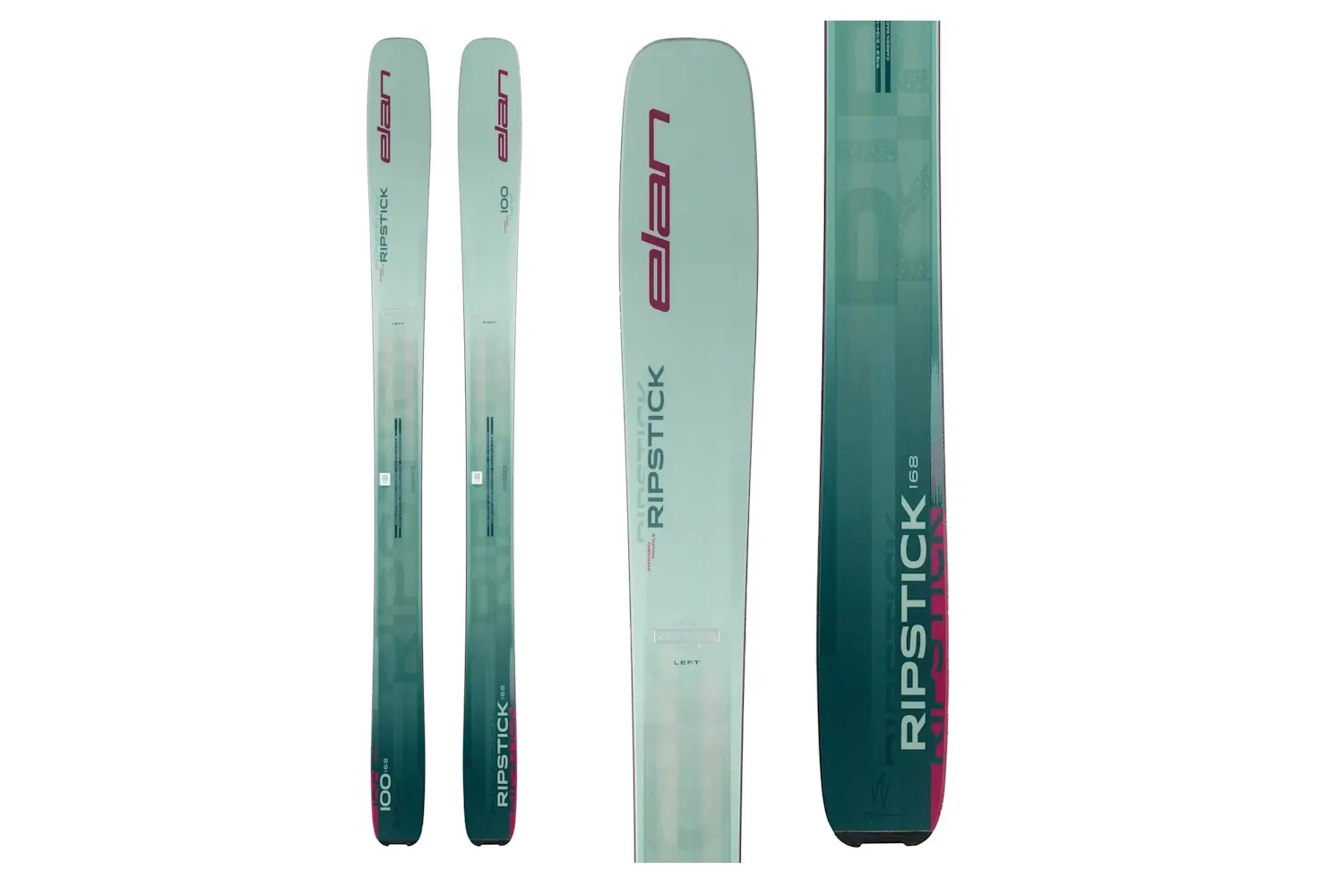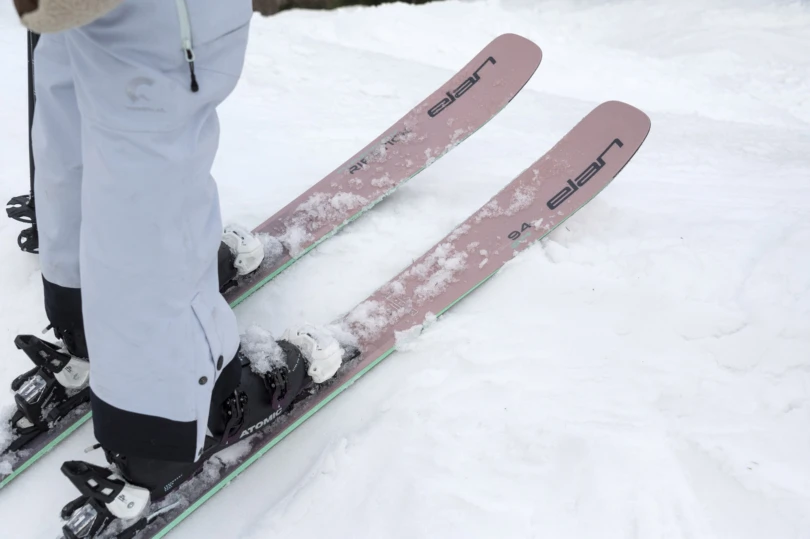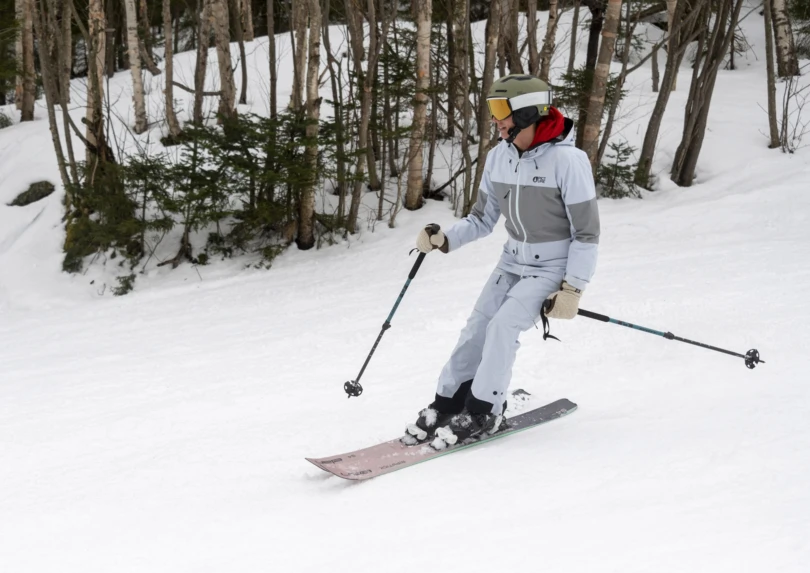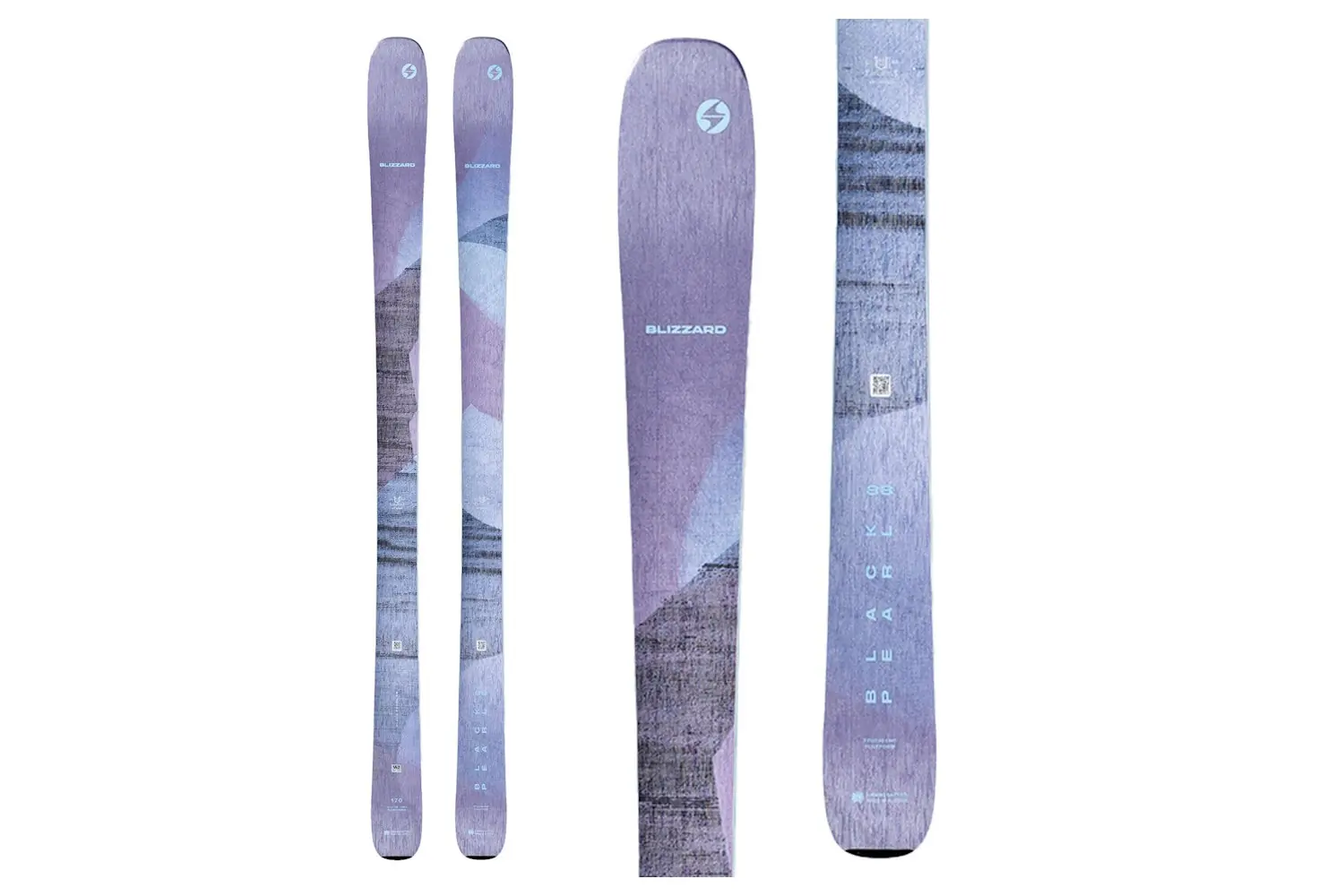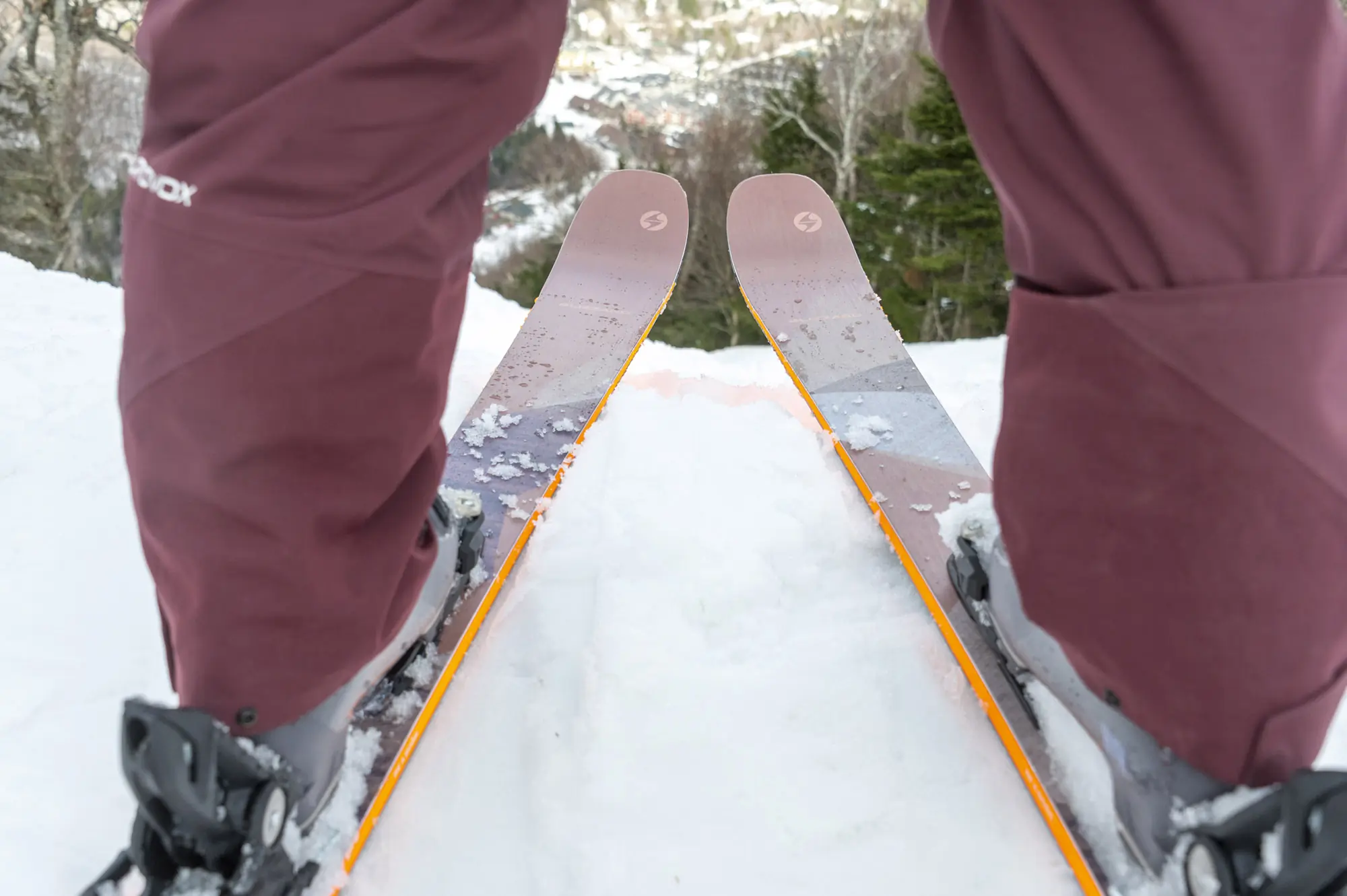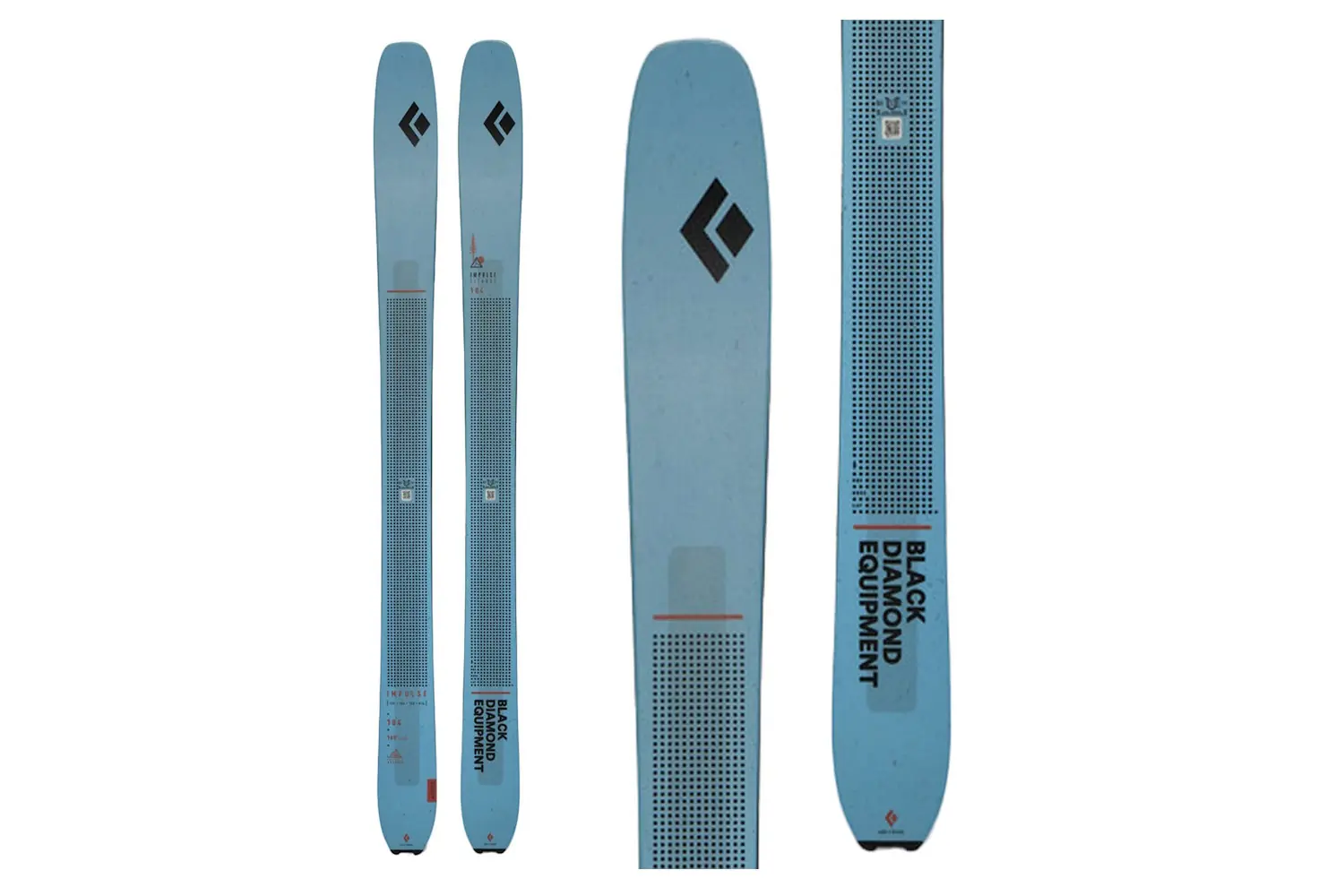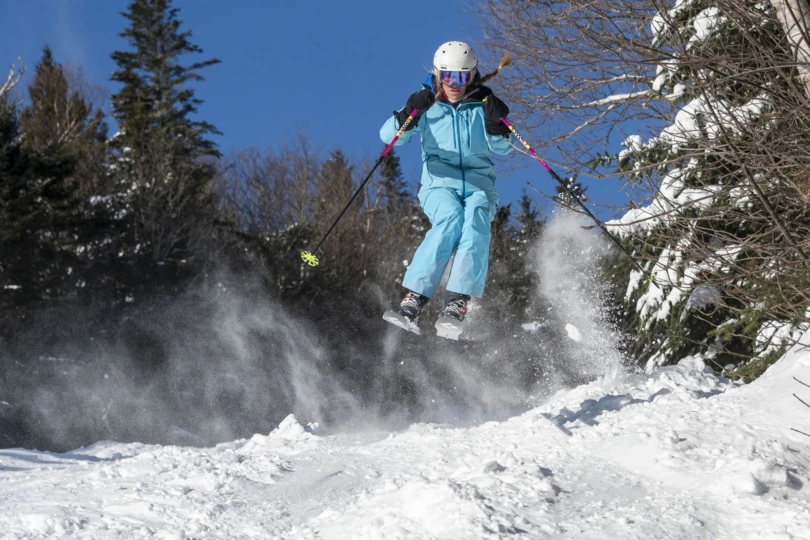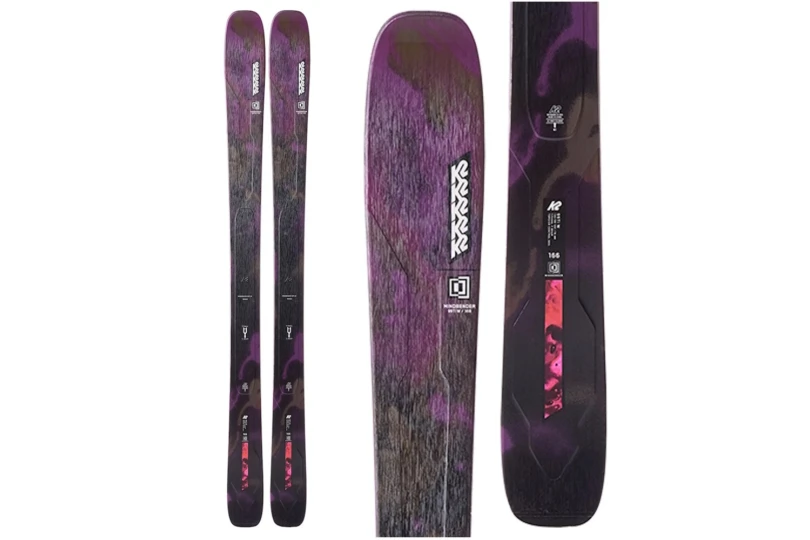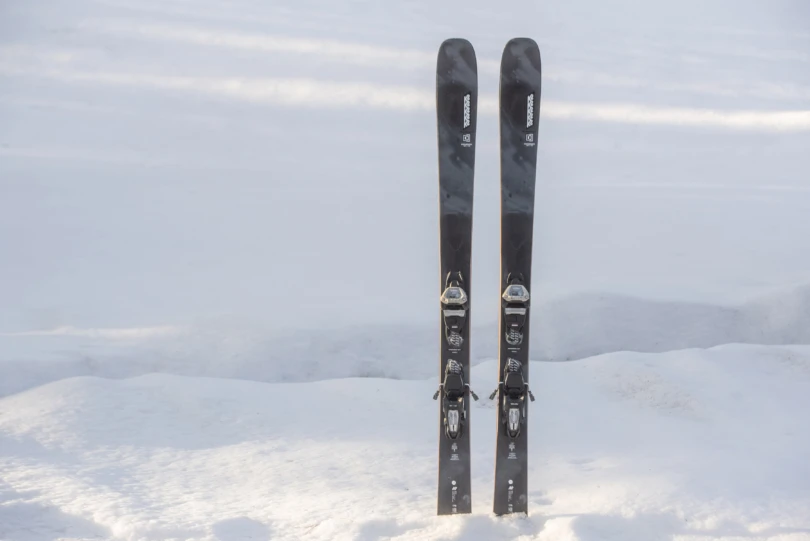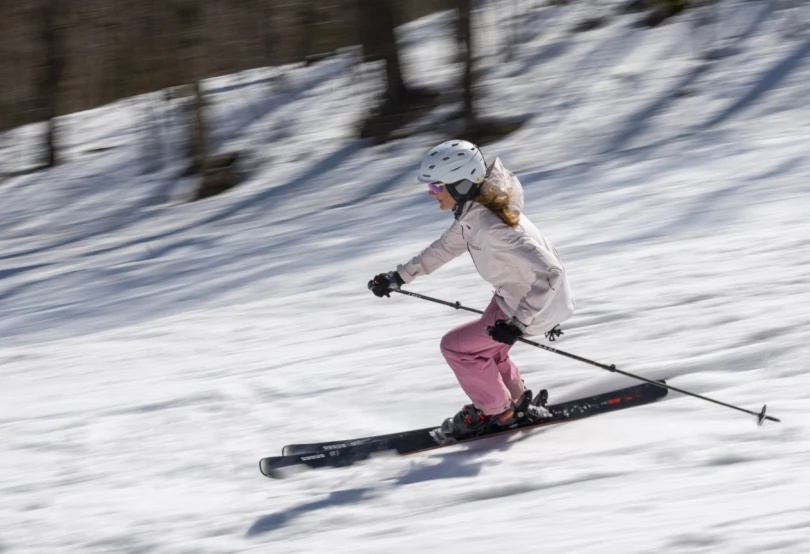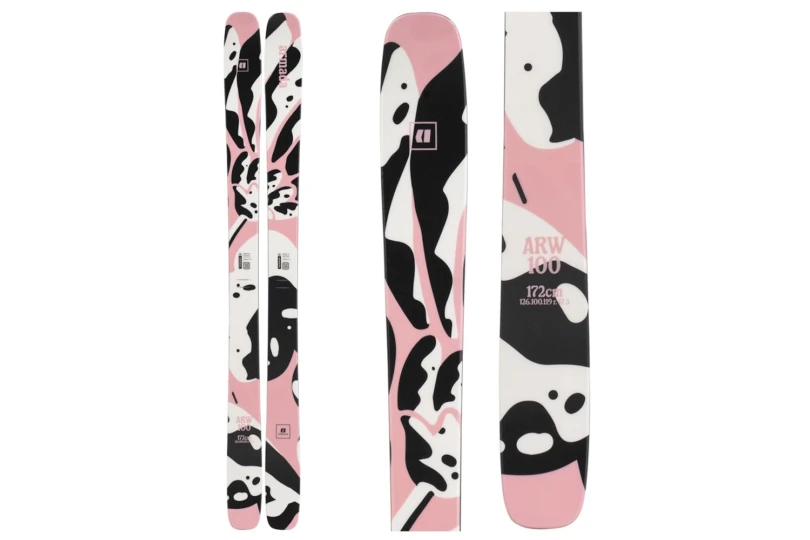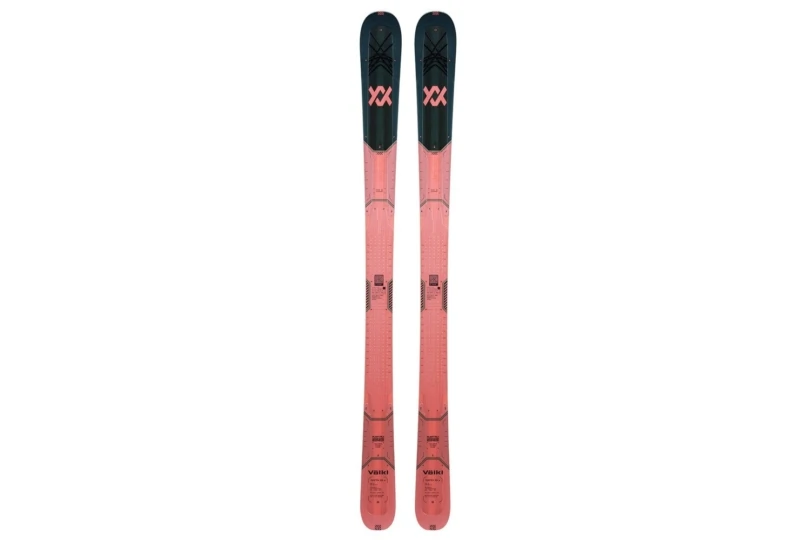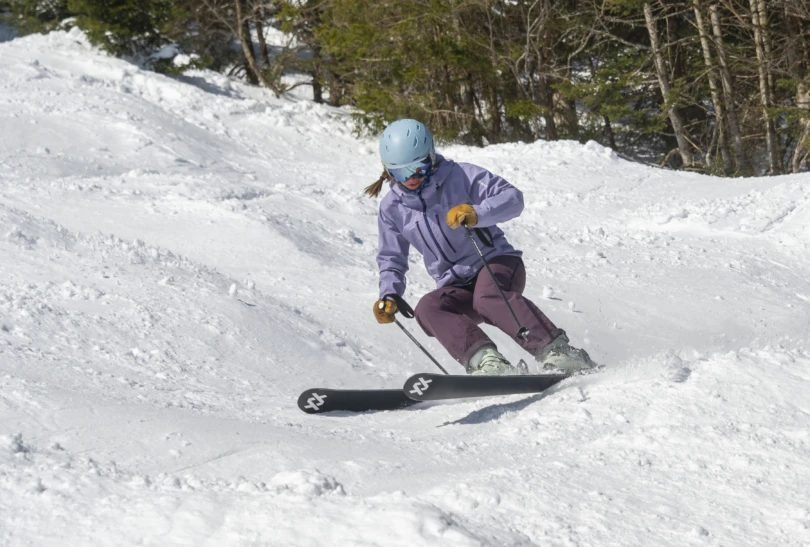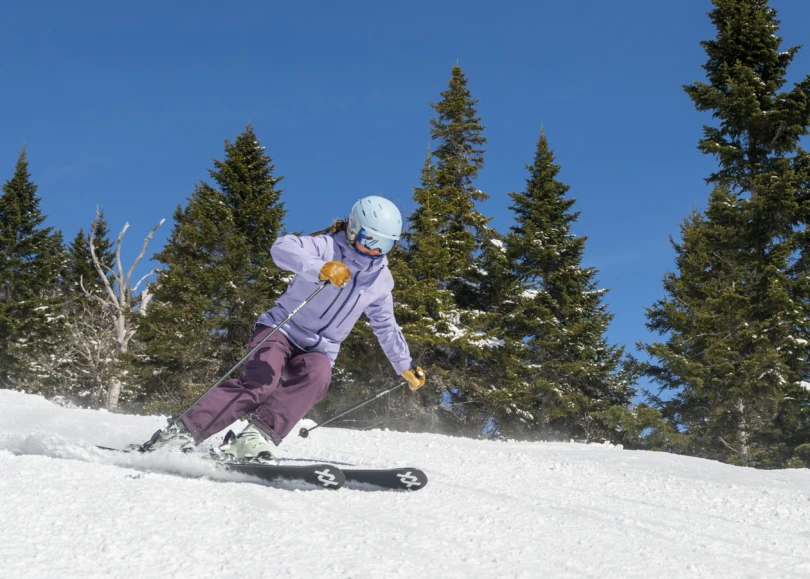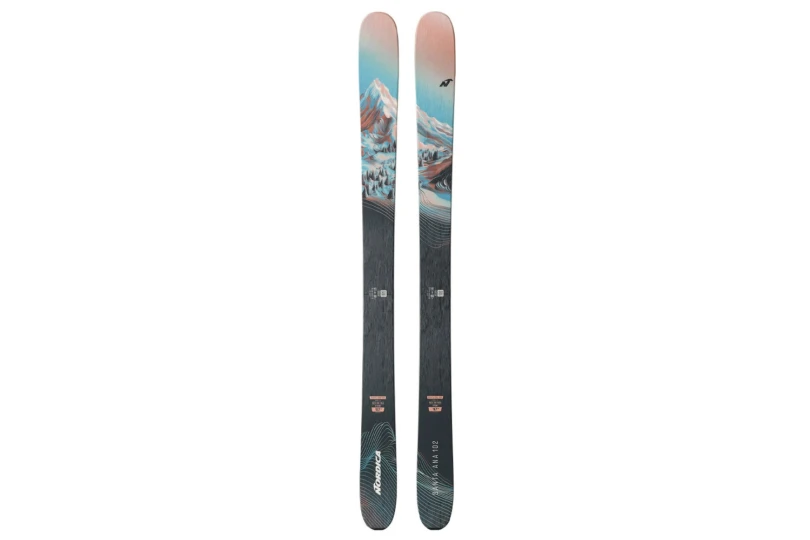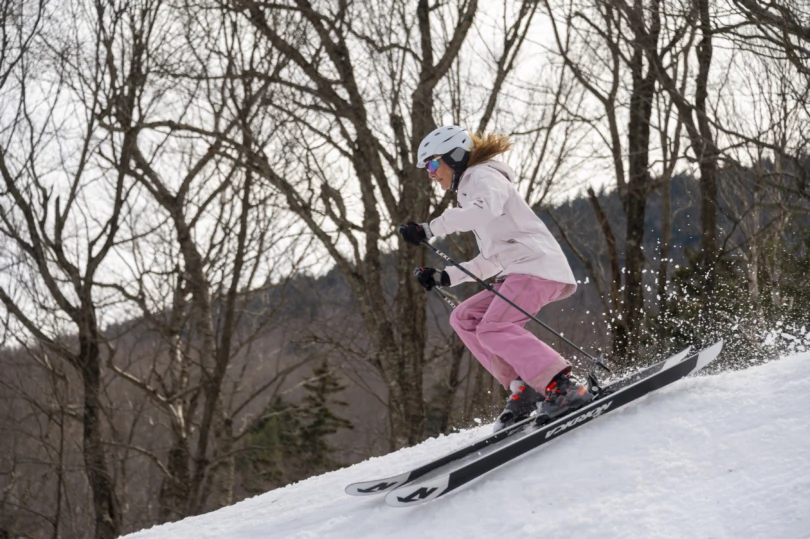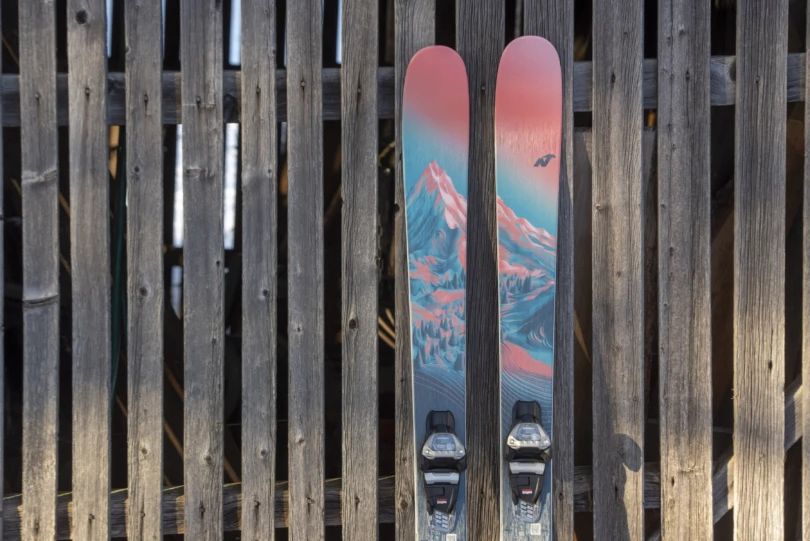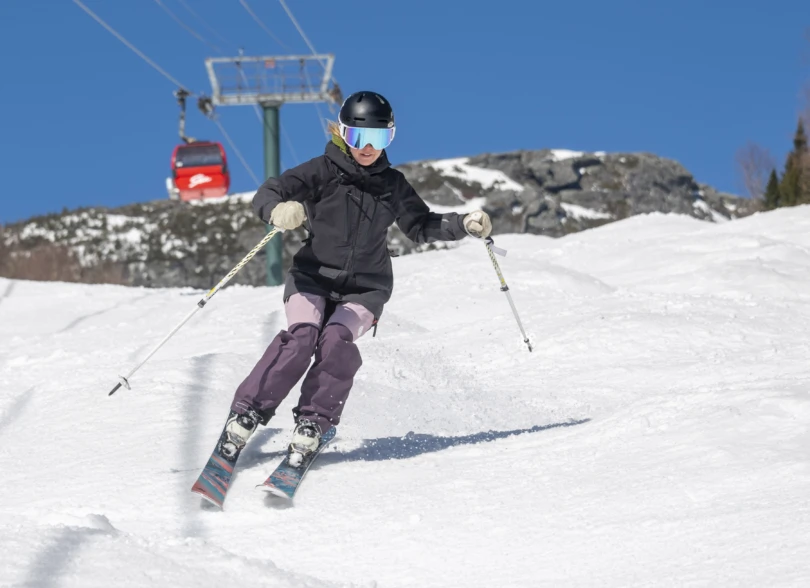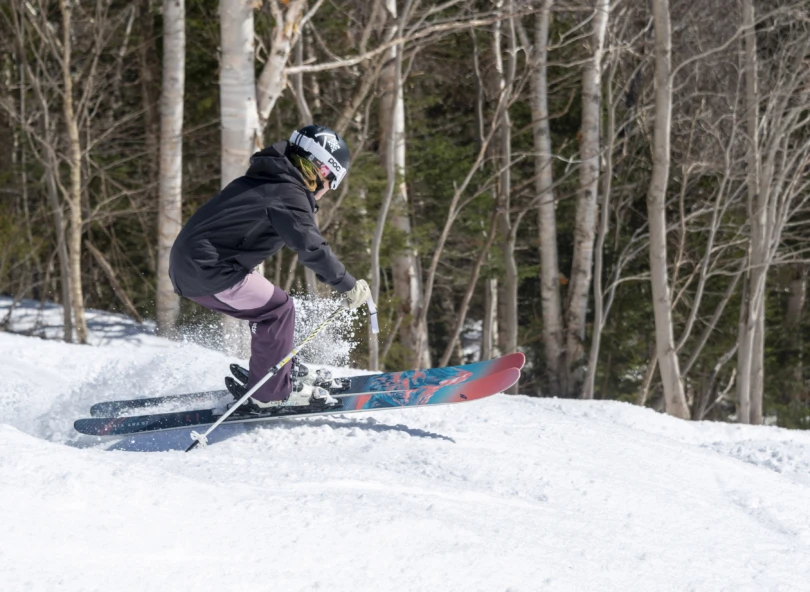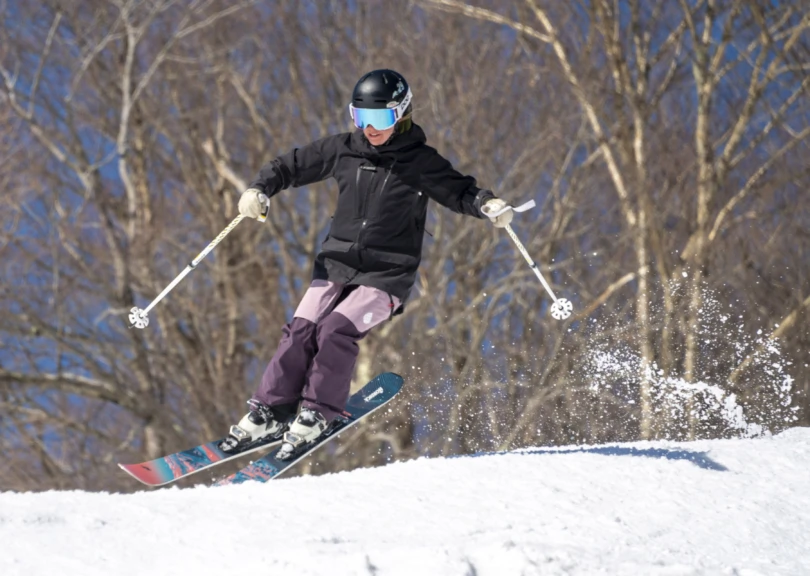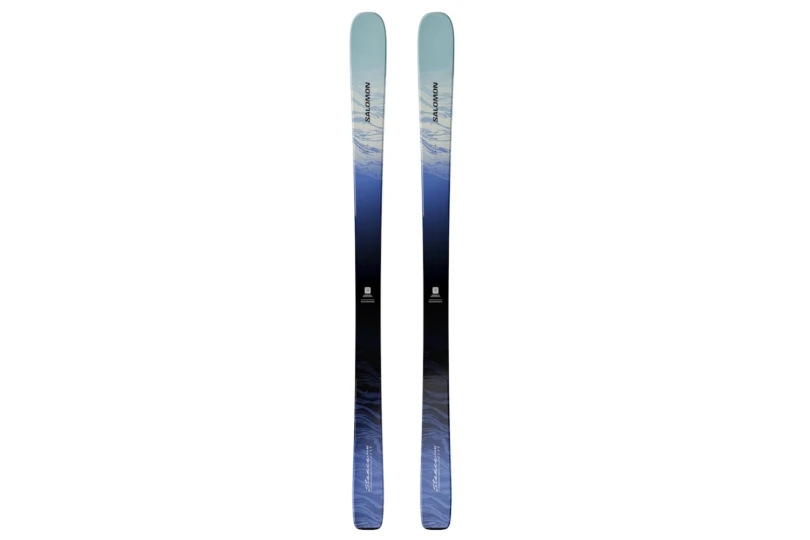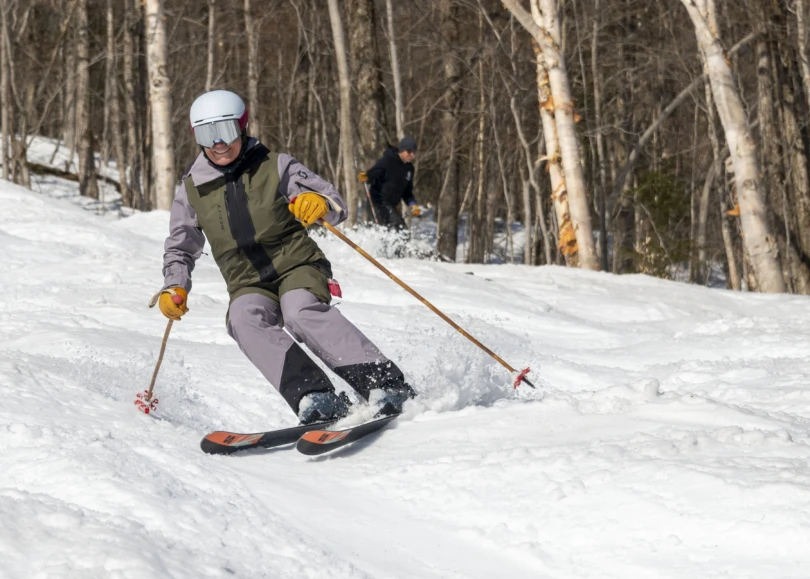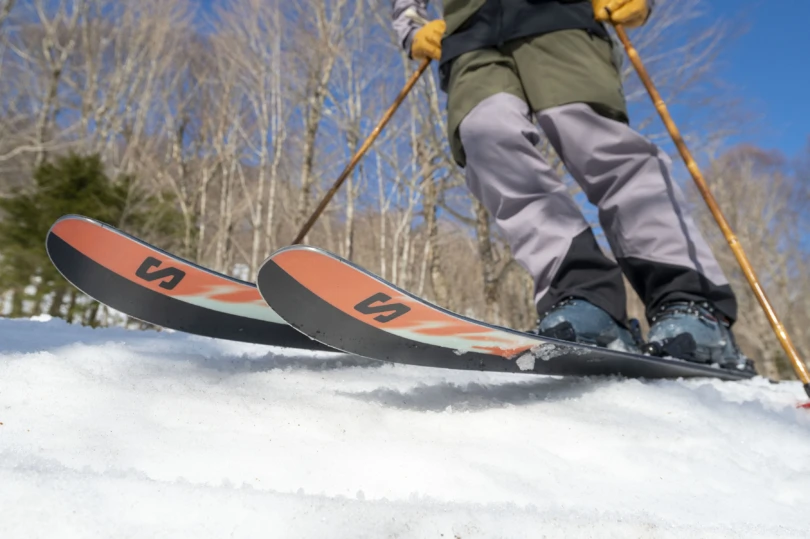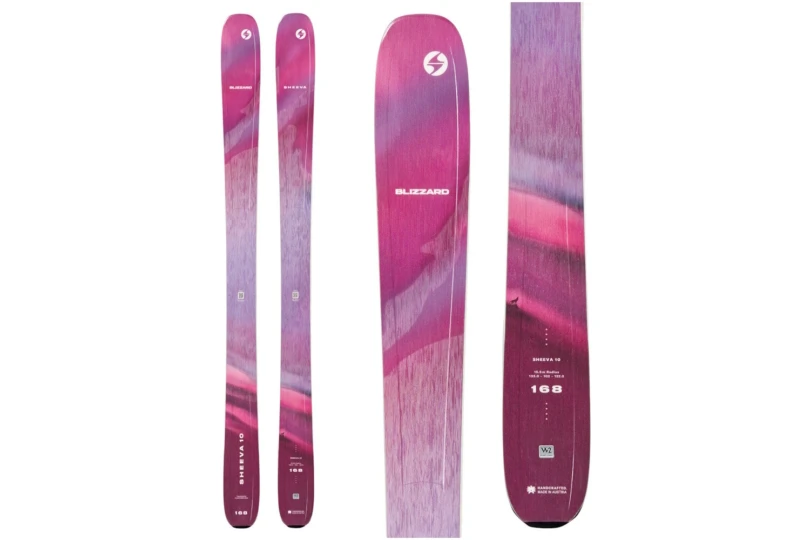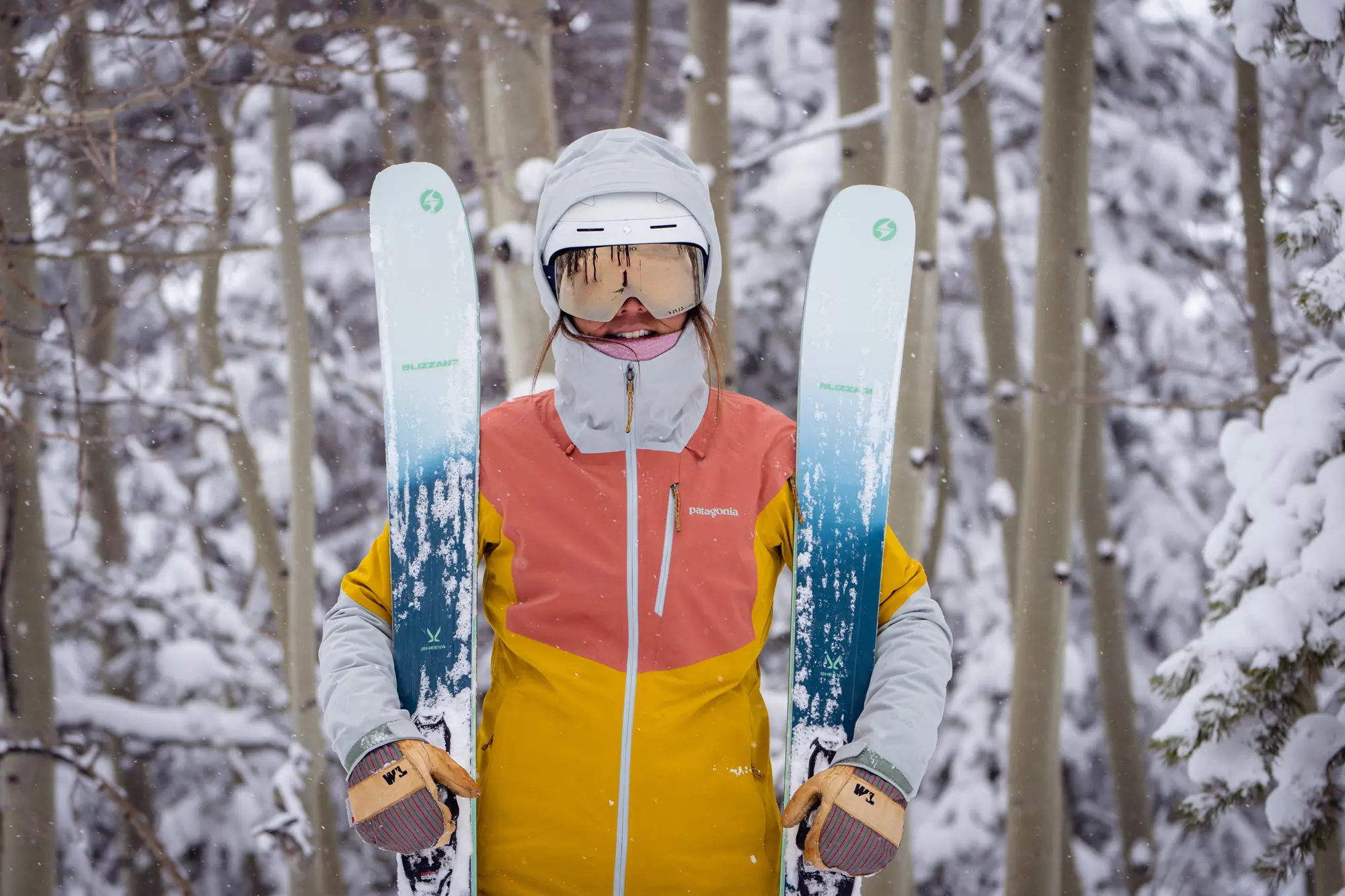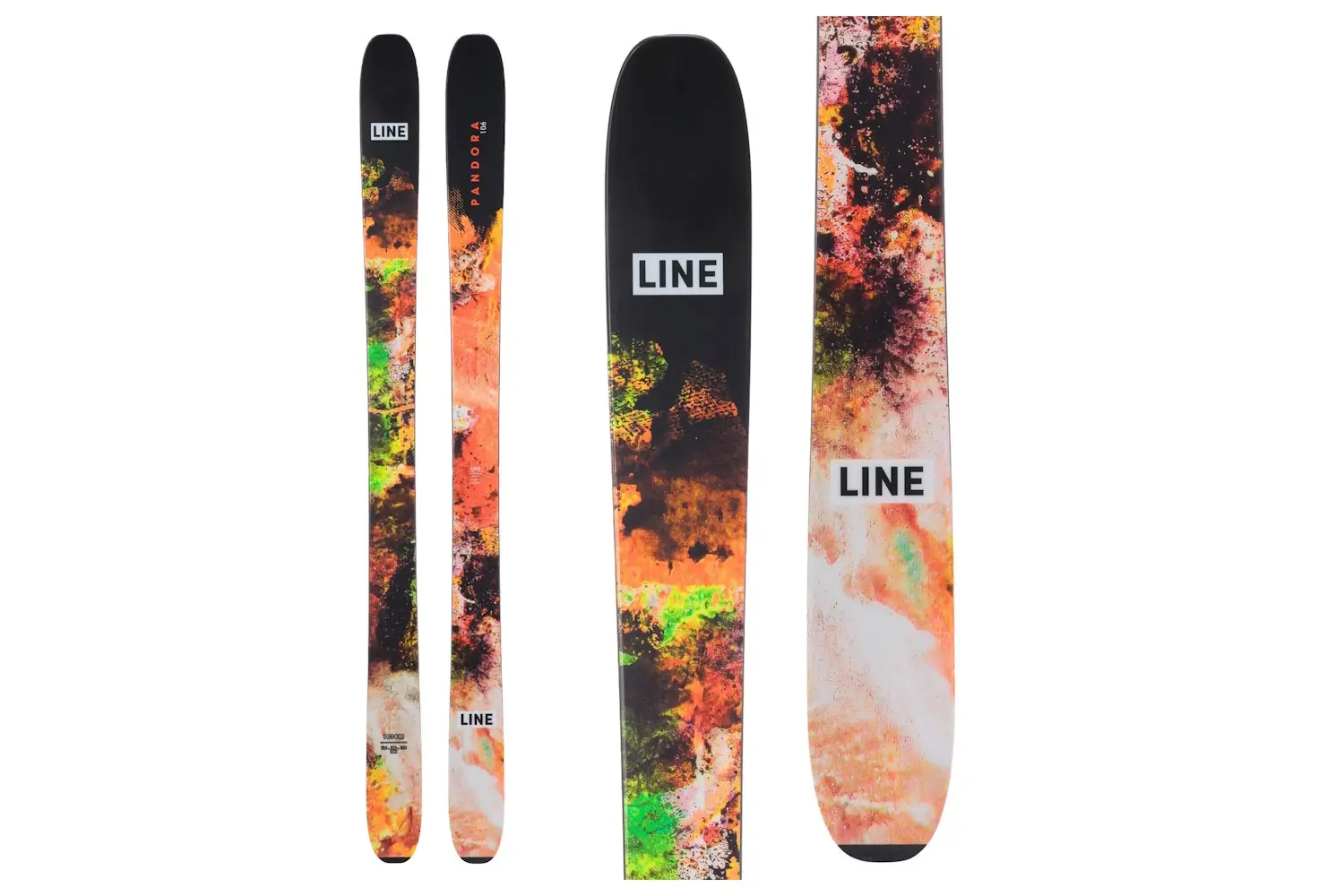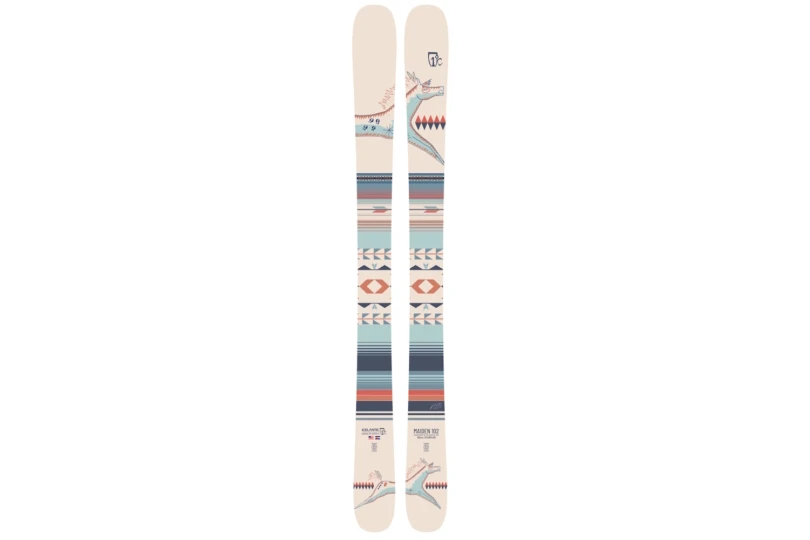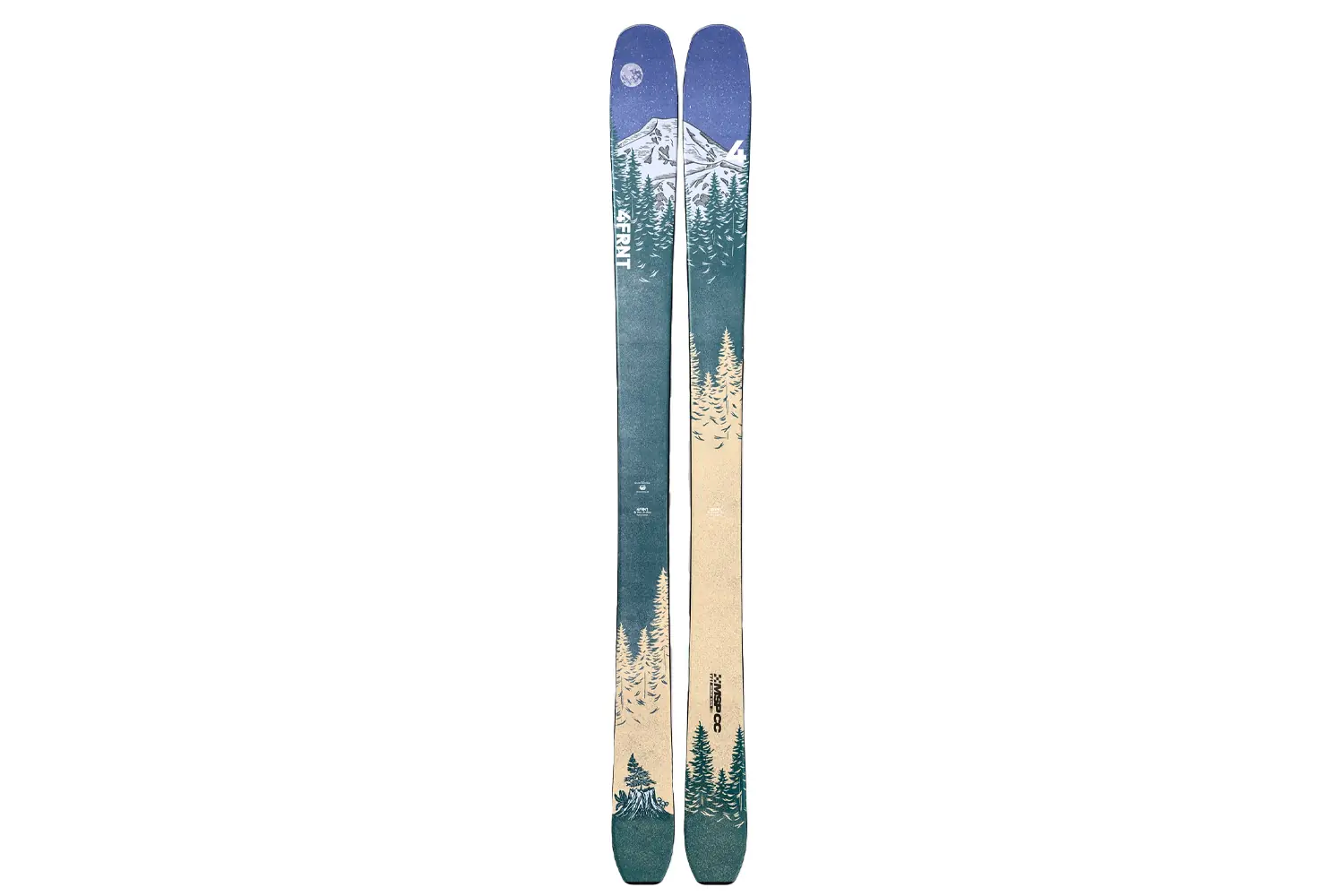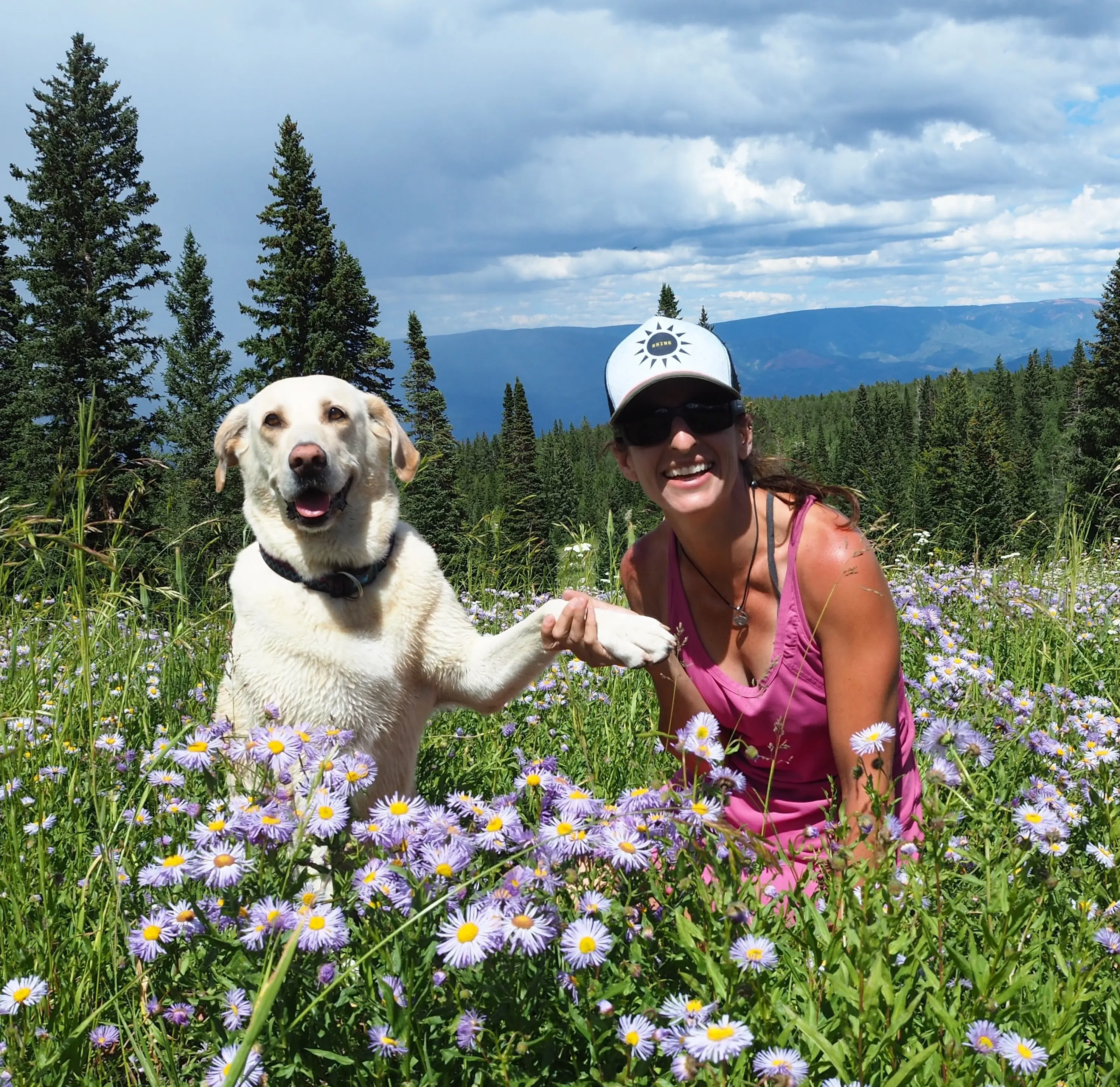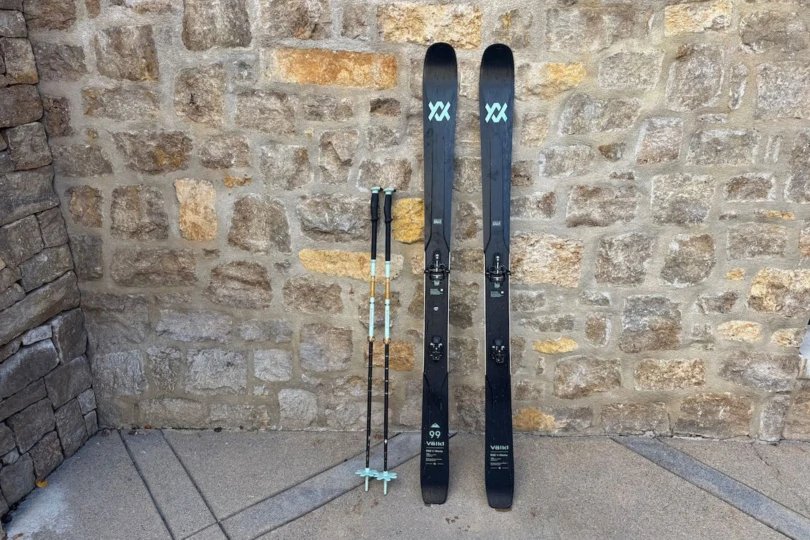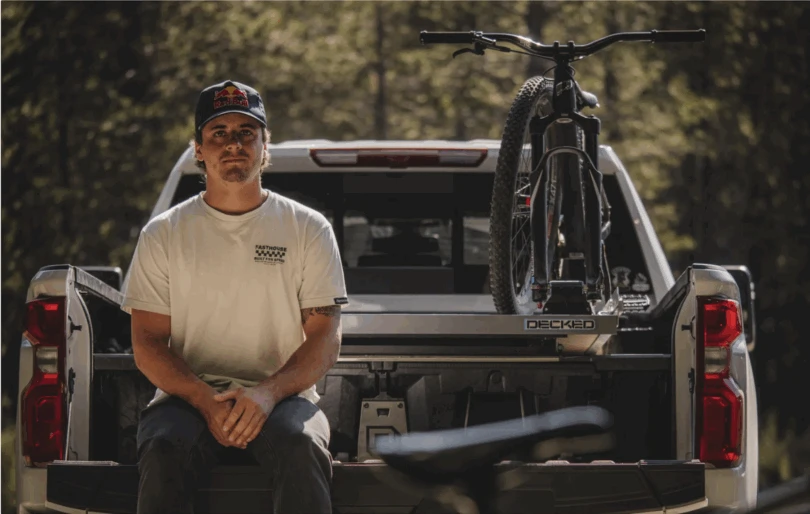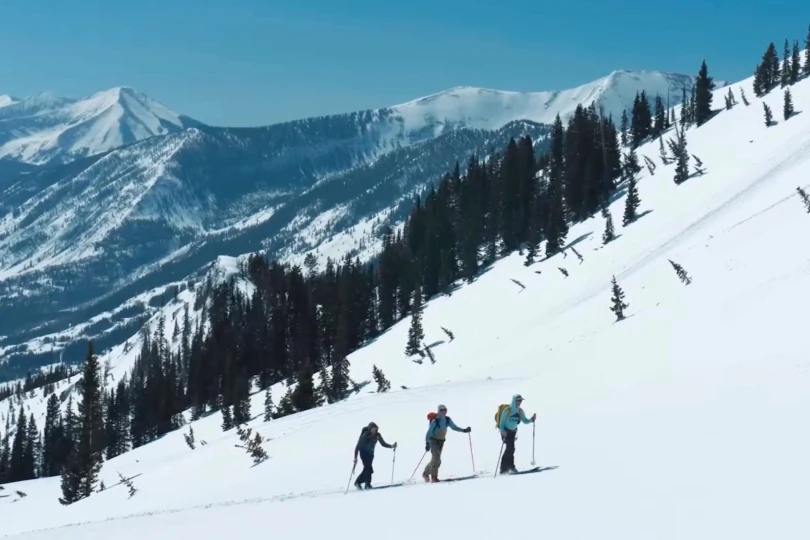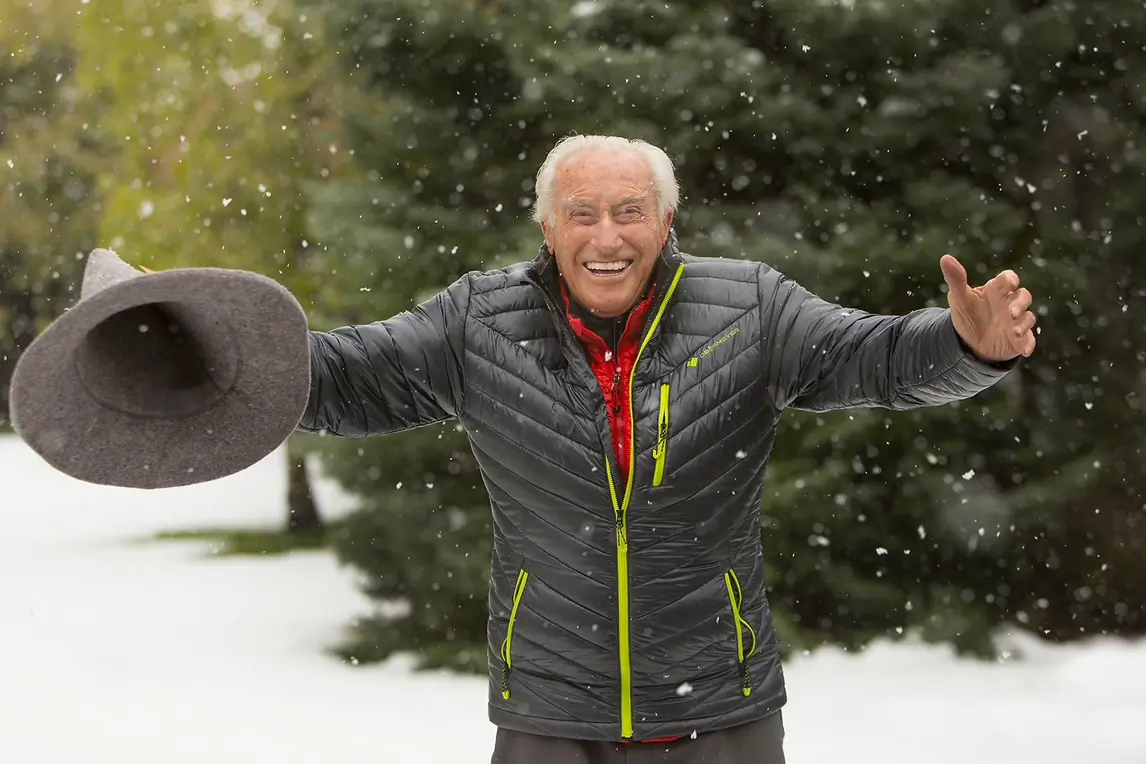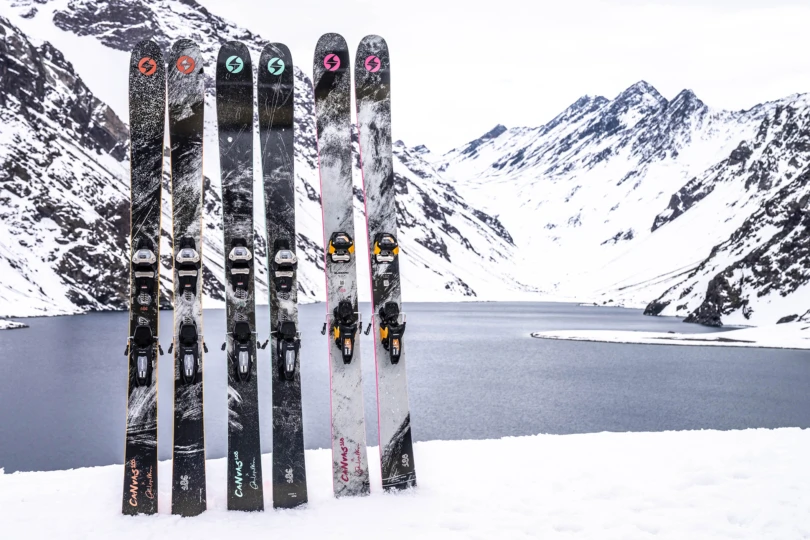From dawn patrol corduroy to hidden powder stashes, the best women’s all-mountain skis are made for skiers who want to do it all. These quiver-of-one workhorses thrive on everything the mountain throws at you — smooth groomers, wind-buffed ridges, or surprise tree runs with friends.
We tested the top contenders in everything from knee-deep powder to East Coast ice, skiing hard at Stowe in Vermont, Jackson Hole in Wyoming, Utah’s Powder Mountain, and more than half a dozen Idaho resorts. What follows is our A-List, the cream of the crop for women’s all-mountain skis.
Whether you’re chasing the all-around excellence of the Atomic Maven 103 CTI or the value-packed performance of the Elan Ripstick 100 W, our picks have you covered from first chair to last lap.
Editor’s Note: On November 10, 2025, we added two new skis to this guide — the Volkl Mantra 88 W, a powerful, confidence-building ski that blends stability and precision across all conditions, and the Nordica Santa Ana 102, a smooth, energetic all-mountain charger that balances strength and playfulness. We also updated our ratings and reviews based on further testing, awarding the K2 Mindbender 99 Ti W as our most versatile ski and the Blizzard Black Pearl 88 as our best for beginners.
The Best All-Mountain Skis for Women of 2025-2026
Atomic Maven 103 CTI
-
Stability at Speed
10.0
-
Playfulness
8.0
-
Powder Performance
8.0
-
Performance in Poor Conditions
9.0
- Price: $975
- Lengths (cm): 156 cm, 162 cm, 170 cm, 178 cm
- Dimensions (mm): 128.5/103/116.5 (162)
- Turn Radius: 16m (162)
- Other Available Waist Widths (mm): 84. 86, 86C, 93C
- Best For: Skiers looking for a one-ski quiver, skiers who like to carve, all-mountain skiers who prefer a slightly wider setup
Pros
- Fun everywhere on the mountain
- Excels at both high and low speeds
- Comes in 178 cm for taller/more aggressive skiers
Cons
- Doesn’t have the grip of a pure frontside ski
- Not as agile as some others
Elan Ripstick 100 W
-
Stability at Speed
10.0
-
Playfulness
7.0
-
Powder Performance
8.0
-
Performance in Poor Conditions
8.0
- Lengths (cm): 154 cm, 161 cm, 168 cm, 175 cm
- Dimensions (mm): 134/100/114 (168)
- Turn Radius: 16.8 (168)
- Other Available Waist Widths (mm): 88,94, 94 Black Edition, 106
- Best For: Everything from variable hardpack to powdery refreshes
Pros
- Super versatile
- Carbon not metal gives big bite, but is light
- Also available in a range of widths
Cons
- Dedicated left & right skis
- Don't have the grip of a frontside ski
Blizzard Black Pearl 88
-
Stability at Speed
8.0
-
Playfulness
6.0
-
Powder Performance
5.0
-
Performance in Poor Conditions
8.0
- Lengths (cm): 146, 152, 158, 164, 170, 176
- Dimensions (mm): 126.5/88/108.5 (164)
- Turn radius: 14m (164)
- Other available waist widths (mm): 84, 94
- Best for: Beginner to intermediate skiers who plan to stay on the slopes
Pros
- One of the top-selling skis in the world in any category
- Designed from the snow up specifically for women
- Comes in short lengths
Cons
- Not a quick handler in the trees
- Not the favorite of more advanced skiers
Black Diamond Impulse Ti 104 W
-
Stability at Speed
9.0
-
Playfulness
8.0
-
Powder Performance
8.0
-
Performance in Poor Conditions
7.0
- Lengths (cm): 158, 165, 172
- Dimensions (mm): 135/104/123 (165)
- Turn Radius: 16m (165)
- Other Available Waist Widths (mm): 98
- Best For: Intermediate to experts, powder days
Pros
- A powder ski that grips in challenging and low snow conditions
- Same weight as the non-metal version
- Impressive performance all over the mountain
Cons
- Longest women’s ski is 170
- Only two waist widths available
K2 Mindbender 99 Ti W
-
Stability at Speed
9.0
-
Playfulness
7.0
-
Powder Performance
7.0
-
Performance in Poor Conditions
8.0
- Lengths (cm): 154, 160, 166
- Dimensions (mm): 134-99-120 (166)
- Turn Radius: 15.4m (166)
- Other Available Waist Widths (mm): 89 Ti, 90C FW, 106C
- Best For: hard-charging skiers looking for a single quiver ski
Pros
- Performs well in a wide range of conditions
- Comes in five sizes
- An insert keeps the middle ski lively in shorter sizes
Cons
- Too much ski for a beginner skier
- Heavier than most
Armada ARW 100
-
Stability at Speed
8.0
-
Playfulness
9.0
-
Powder Performance
7.0
-
Performance in Poor Conditions
7.0
- Lengths (cm): 158, 165, 172, 179
- Dimensions (mm): 126-100-119 (172 cm)
- Turn radius: 17.5 (172 cm)
- Other available waist widths (mm): 94, 88, 84
- Best for: Skiers who like the playful feel of an all-mountain twin tip
Pros
- Light and energetic
- Park-friendly design that is fun everywhere on the mountain
- Built to be durable
Cons
- Doesn’t excel in chop
- Can get pushed around by heavy or wet snow
Other Women’s All-Mountain Skis We Love to Shred
-
Stability at Speed
8.0
-
Playfulness
5.0
-
Powder Performance
6.0
-
Performance in Poor Conditions
8.0
- Lengths (cm): 149 cm, 156cm, 163 cm, 170 cm
- Dimensions (mm): 134 mm / 88 mm / 114 mm
- Turn Radius: (R1) 23.5 m, (R2) 13.2 m, (R3) 21.3 m (163)
- Other Available Waist Widths (mm): 84, 102
- Best For: Carving, moguls, and hard-packed or moderate snow
Pros
- Excellent edge grip and stability on firm snow
- Powerful yet smooth through chopped terrain
- Surprisingly strong float and easy turn initiation
- Confidence-inspiring at speed
Cons
- Requires a skilled, active skier
- Not as playful or forgiving as softer all-mountain skis
-
Stability at Speed
8.5
-
Playfulness
6.8
-
Powder Performance
7.0
-
Performance in Poor Conditions
8.0
- Lengths (cm): 155 cm, 161 cm, 167 cm, 173 cm, 179 cm
- Dimensions (mm): 129 mm/102 mm/119 mm
- Turn Radius (for one length): 17m
- Other Available Waist Widths (mm): 82, 87, 92 mm, 97 mm
- Best For: Hard-charging women who want a powerful ski
Pros
- Smooth, stable, and confidence-inspiring ride
- Excellent edge hold and damping on firm or variable snow
- Powerful yet surprisingly playful for a metal ski
- Handles a wide range of terrain with ease
Cons
- Heavier than some all-mountain options
- Requires an engaged skier to unlock its full potential
-
Stability at Speed
10.0
-
Playfulness
6.0
-
Powder Performance
4.0
-
Performance in Poor Conditions
10.0
- Lengths (cm): 151, 161. 169, 177
- Dimensions (mm): 123-82-106
- Turn Radius: 14m (169)
- Other Available Waist Widths (mm): Women's 88 & Unisex 96, 90, 86, 82
- Best For: An intermediate/advance piste skier looking for a racy, powerful ski that isn’t confined to groomers
Pros
- Powerful
- Stable
- Fast
Cons
- Doesn’t excel in powder
- Prefers piste
-
Stability at Speed
8.0
-
Playfulness
7.0
-
Powder Performance
8.0
-
Performance in Poor Conditions
8.0
- Price: $800
- Lengths (cm): 156,162,168,174,180
- Dimensions (mm): 133.5/102/122.5 (174)
- Turn Radius: 16m (174)
- Other Available Waist Widths (mm): 96, 112
- Best For: Beginner to advanced resort skiers who like to ski all over the mountain
Pros
- A great choice for aggressive skiers, and beginners who want to grow into their skis
- Solid edge hold and a smooth ride
- Available in a wide range of sizes
Cons
- Not available in narrow widths
- Don’t perform well if ice and hardpack are the most common surfaces you ski
-
Stability at Speed
7.0
-
Playfulness
9.0
-
Powder Performance
9.0
-
Performance in Poor Conditions
7.0
- Price: $650
- Lengths (cm): 155, 162, 169, 176, 183, 189
- Dimensions (mm): 134/106/125
- Turn Radius: 16.7m (176)
- Other Available Waist Widths (mm): 85, 92, 99
- Best For: All-Mountain freeriding, all-mountain, all conditions, and everything in between
Pros
- Incredibly playful and lightweight
- Easy to maneuver and nimble, yet reliable
- Very reasonable price point
- Predictable and energetic
Cons
- Not the best on icy groomers
- No longer women-specific
-
Stability at Speed
8.0
-
Playfulness
8.0
-
Powder Performance
9.0
-
Performance in Poor Conditions
7.0
- Lengths (cm): 155, 162, 169
- Dimensions (mm): 137/102/129 (all sizes)
- Turn Radius: 14.5m (162)
- Other Available Waist Widths (mm): 94, 108
- Best For: Freeriding winter cowgirls
Pros
- Balance of float and edge-to-edge transfer
- Easy to drive
- Clever component design to reduce chatter
Cons
- Can get a bit squirrelly on hardpack
- Not the most aggressive ski
-
Stability at Speed
7.0
-
Playfulness
7.0
-
Powder Performance
9.0
-
Performance in Poor Conditions
6.0
- Lengths (cm): 159, 165, 171
- Dimensions (mm): 132/99/121 (165)
- Turn Radius: 16m (165)
- Other Available Waist Widths (mm): N/A
- Best For: Intermediate to expert skiers
Pros
- The weight enhances stability and damping
- Fairly forgiving
Cons
- Not the strongest performer in icy conditions
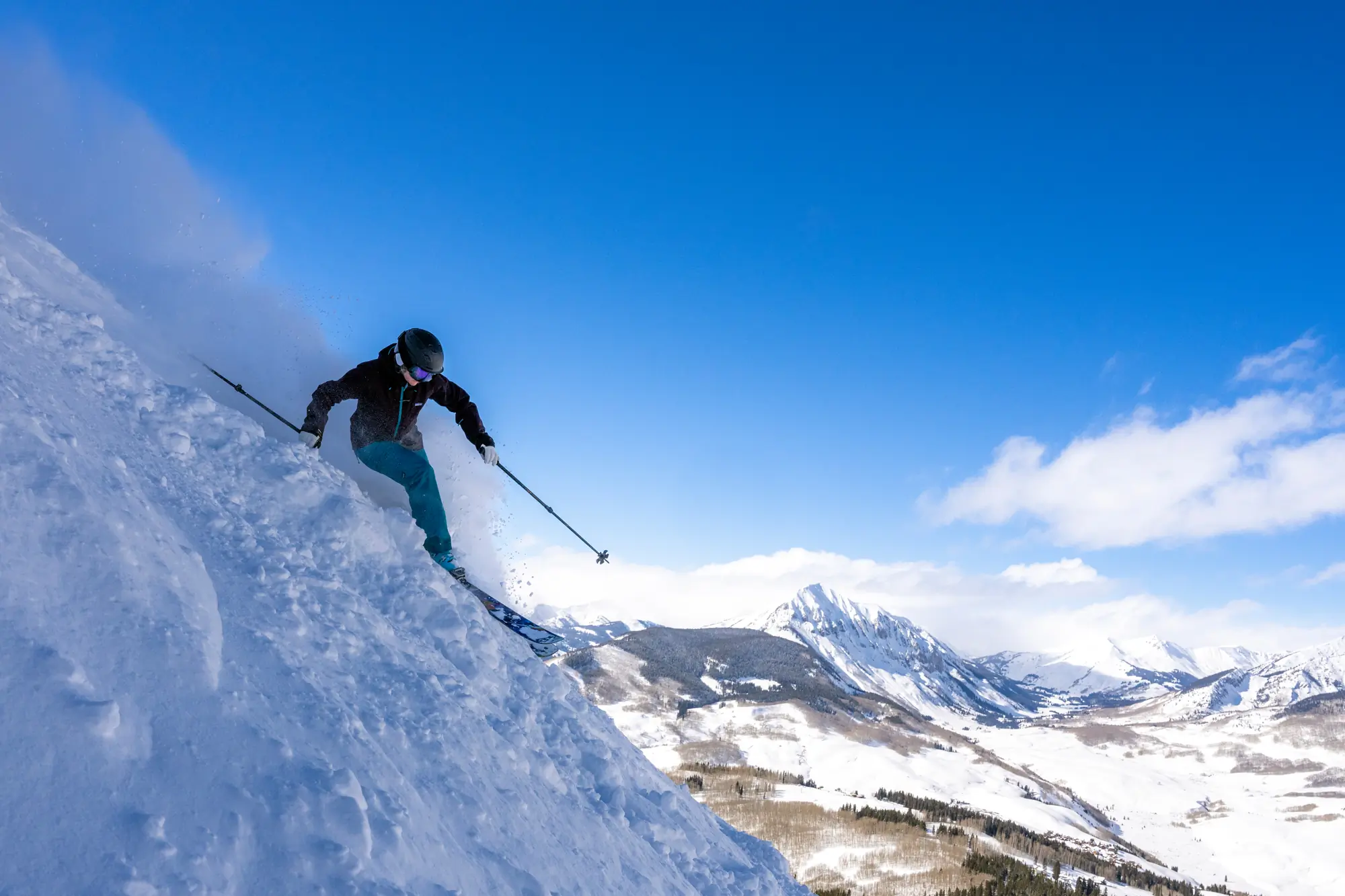
Women’s All-Mountain Skis Comparison Chart
Scroll right to view all of the columns.
| All-Mountain Skis for Women | Price | Lengths (cm) | Dimensions (mm) | Turn Radius | Best For |
|---|---|---|---|---|---|
| Atomic Maven 103 CTI | $975 | 156, 162, 170, 178 | 128.5/103/116.5 (162) | 16m (162) | Skiers looking for a one-ski quiver, skiers who like to carve, all-mountain skiers who prefer a slightly wider setup |
| Elan Ripstick 100 W | $750 | 154,161,168 | 134/100/114 (168) | 16.8 (168) | East Coast skiers, including those who plan to travel to ski; icy groomers to anything else the mountain can dish out; skiers who want maximum control |
| Blizzard Black Pearl 88 | $700 | 146, 152, 158, 164, 170, 176 | 126.5/88/108.5 (164) | 14m (164) | Beginner to intermediate skiers who plan to stay on the slopes |
| Black Diamond Impulse Ti 104 W | $850 | 158, 165, 172 | 135/104/123 (165) | 16m (165) | Intermediate to experts, powder days |
| Mindbender 99 Ti W | $800 | 154, 160, 166 | 134-99-120 (166) | 15.4m (166) | Hard-charging skiers looking for a single quiver ski |
| Armada ARW 100 | $700 | 158 cm, 165 cm, 172 cm, 179 cm | 126-100-119 (172) | 17.5 (172) | Skiers who like the playful feel of an all-mountain twin tip |
| Salomon Stance Pro 82 W | $750 | 151, 161. 169, 177 | 123-82-106 (169) | 14m (169) | An intermediate/advance piste skier looking for a racy, powerful ski that isn’t confined to groomera |
| Volkl Mantra 88 W | $850 | 149, 156, 163, 170 | 134-88-114 | 23.5m (163) | Carving, moguls, and hard-packed or moderate snow |
| Nordica Santa Ana 102 | $900 | 155, 161, 167, 173, 179 | 129-102-119 | 17 m | Hard-charging women who want a powerful ski |
| Blizzard Sheeva 10 | $800 | 156,162,168,174,180 | 133.5/102/122.5 (174) | 16m (174) | Beginner to advanced resort skiers who like to ski all over the mountain |
| Line Pandora 106 | $650 | 155, 162, 169, 176, 183, 189 | 134/106/125 | 16.7m (176) | All-Mountain freeriding, all-mountain, all conditions, and everything in between |
| Icelantic Maiden 102 | $850 | 155, 162, 169 | 137/102/129 (all sizes) | 14.5m (162) | Freeriding winter cowgirls |
| 4FRNT MSP CC | $729 | 159, 165, 171 | 132/99/121 (165) | 16m (165) | Intermediate to expert skiers |
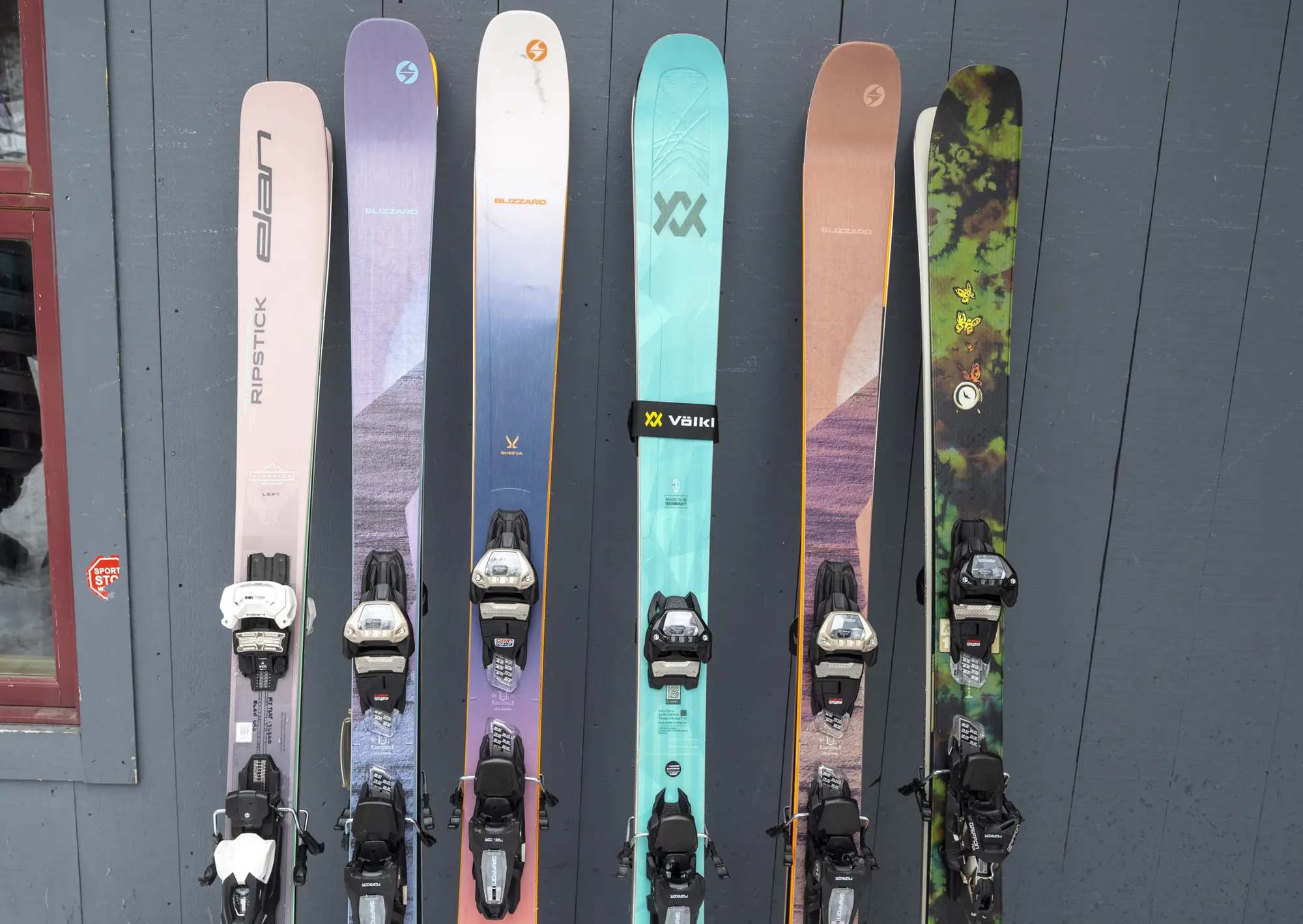



How We Tested Women’s All-Mountain Skis
Our Expert Testers
The GearJunkie product testing team is made up of alpine and backcountry skiers who test skis worldwide. Lead women’s all-mountain ski tester Berne Broudy is an avid skier who calls Stowe Mountain Resort home. She regularly ventures as far and wide as she can to ski. Recent adventures include Norway, Austria, Iceland, and Greenland.This season, her adventures took her to Jackson Hole, where 66” of powder fell in a week. She also skied at Powder Mountain, Utah, where a huge snowstorm forced her evacuation from a backcountry hut in a blizzard by snowcat.
Senior Editor Morgan Tilton started alpine skiing in her backyard at Telluride Ski Resort at age 4. Three decades later, she backcountry skis in addition to snowboarding and splitboarding in Gunnison County, where she lives today.
Our Testing Grounds and Process
For over a decade, we’ve been testing women’s all-mountain skis. We’ve skied them from hut-to-hut all over North America and bell-to-bell resort powder from Virginia to Japan. Whether we were training for the country’s toughest skimo races, guiding expeditions, or donning costumes on the slopes, we did it with these skis on our feet. We’ve skied the East, ridden chairs from singles to six packs, crushed couloirs, and slarved through spring slush.
We put this season’s newest all-mountain skis to the test for hundreds of runs at more than a dozen resorts. While we focused on skis made specifically for women, we also included a few unisex options. If you’re looking specifically for men’s skis, check out our guide to the best all-mountain skis.
We took to the slopes in a range of conditions, including thigh-deep pow, below-zero temperatures, blizzards, blustery wind, ice, intense sun, and even rain. While testing skis in-bounds, we assessed each design’s stiffness, maneuverability, and playfulness, as well as the ski’s energy, damping, chatter, weight, shape, edge hold, and turn initiation. We also considered how the size, width, base, and edge tune influenced a ski’s performance. The entire time, we were focused on figuring out the type of skier and conditions that were the best fit for each ski.
In addition to our team’s experience, we considered the most innovative, award-winning, and best-selling skis on the market, as well as a wide range of price points, features, and applications. If you want to round out your kit, check out our guides to the best ski goggles, best ski bibs, best face coverings for skiing, and the best ski jackets.
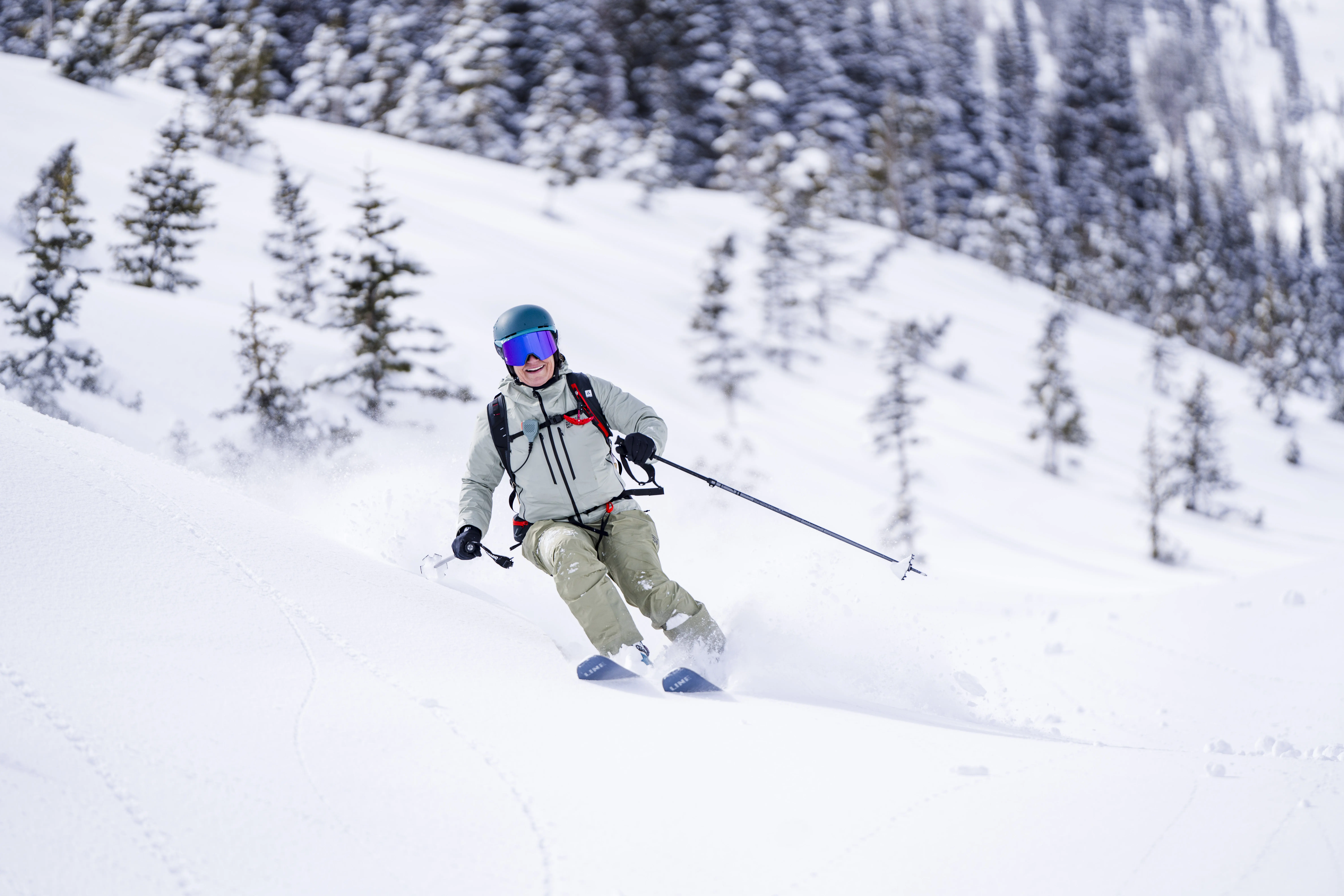



Buyer’s Guide: How to Choose the Best All-Mountain Skis
‘All-Mountain’ Defined
All-mountain skis are designed to perform well everywhere on the mountain. From steeps to moguls to groomers and in any snow conditions from powder to crust to icy hardpack, an all-mountain ski is made to be all-around awesome, though each ski excels in certain conditions.
With any of the skis listed in this guide, you’ll be able to explore the resort as you please, from wide-open groomers to pow-laden trees. But if you’re a storm skier, choose one on the wider side. If you routinely hit the hardpack and really love groomed terrain, a ski under 100mm in the waist will be the best choice. Most all-mountain skis have a mid-wide waist between 85 and 105 mm.
Additionally, most skis in this category have a traditional shape and profile. With camber underfoot and rocker at the tip and the tail, all-mountain skis are versatile masters of the mountain. Within this jill-of-all-trades category, all-mountain skis can have particular strengths and weaknesses:
- All-Mountain: Classic all-mountain skis are built to do it all and usually feature a rocker-camber-rocker construction, like Blizzard’s Black Pearl 88.
- Freeride: Freeride-specific skis are meant for hard-charging, expert skiers who want to ski fast, drop cliffs, and ride at max speeds. Skis that are best for freeride generally feature a longer turning radius and are a bit wider for powder skiing. Two of our favorites are Line’s Pandora 106 and Black Diamond’s Impulse Ti W.
- Backcountry: The best skis for the backcountry are on the lighter side, and some all-mountain skis are perfectly suited to mounting with a hybrid binding so that you can tour on them, too.
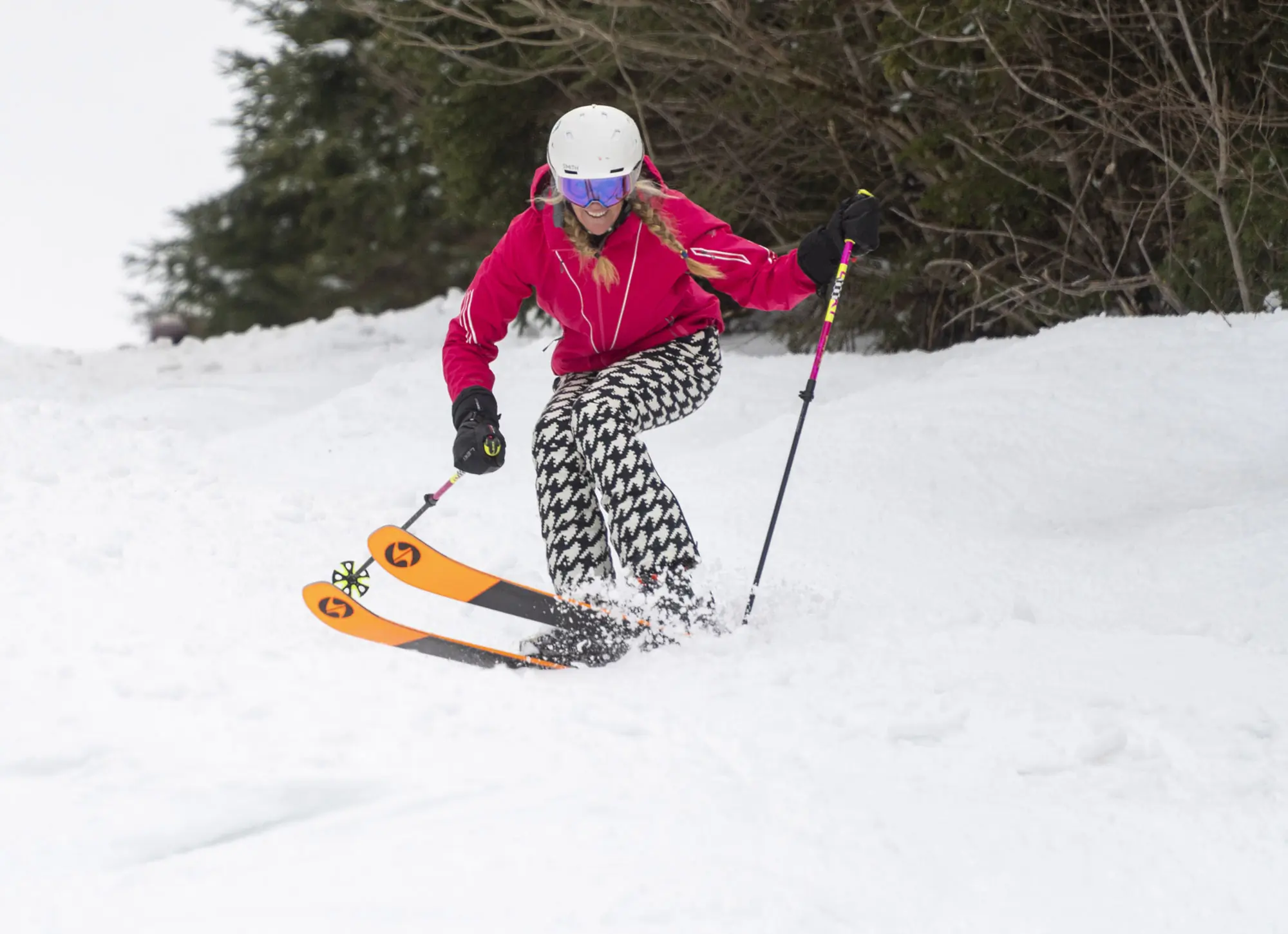



Types of All-Mountain Skis
All of the skis on this list prioritize versatility and can readily venture onto all parts of the mountain. Still, “all-mountain” is ultimately a spectrum that contains multiple subcategories of skis. Many skiers like to explore the whole mountain while also maintaining a preference for a certain style of skiing or type of terrain.
Groomer-Leaning All-Mountain Skis
Skis in this category will perform at their best on groomed runs and firm snow conditions. Typically, groomer-leaning all-mountain skis have a relatively narrow waist width between 85 and 95 mm. On firm snow, an ultra-wide ski can be harder to control.
Skis in the groomer-leaning category prioritize stiffness, high-speed stability, and edge hold. While groomer-leaning all-mountain skis tend to sacrifice float in the deep powder, they’re unbeatable for hard carving and sending it down firm runs with control.
Groomer-leaning skis are especially worth considering for people in the Midwest and East Coast. The Blizzard Black Pearl is exceptional on groomers.
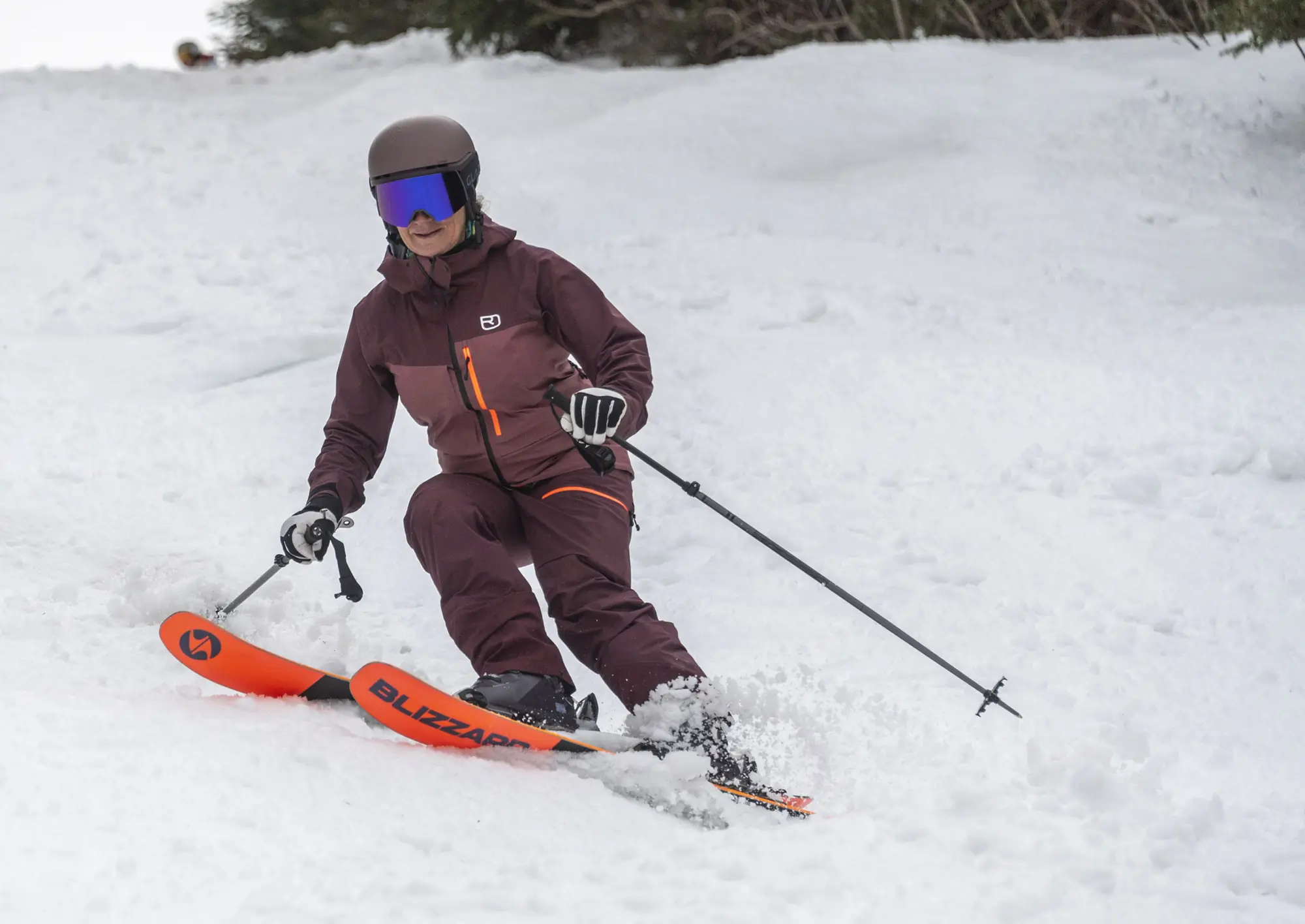



Powder-Leaning All-Mountain Skis
Powder-leaning all-mountain skis are built to thrive in the deep stuff. Generally, skis in this category have a waist width between 95 and 110 mm. If powder lines (and backcountry skiing) are your jam, these are the skis for you.
Skiers in regions with lots of snowfall such as the Cascades and the Wasatch — should certainly consider this category. If you’re a powder hound, check out the Blizzard Sheeva.
Backcountry-Leaning All-Mountain Skis
Some all-mountain skis excel both in-bounds and out. These skis generally feature a lightened-up construction with integrated materials like carbon to add stiffness without the weight penalty of metal. Skis in this category are a great option for getting into the backcountry without the need for an additional pair of skis. A hybrid setup won’t be the lightest setup, but it’s a great place to start for the backcountry curious. Both the Faction Dancer and the Atomic Maven are great choices if you’re going back and forth between the resort and the backcountry.
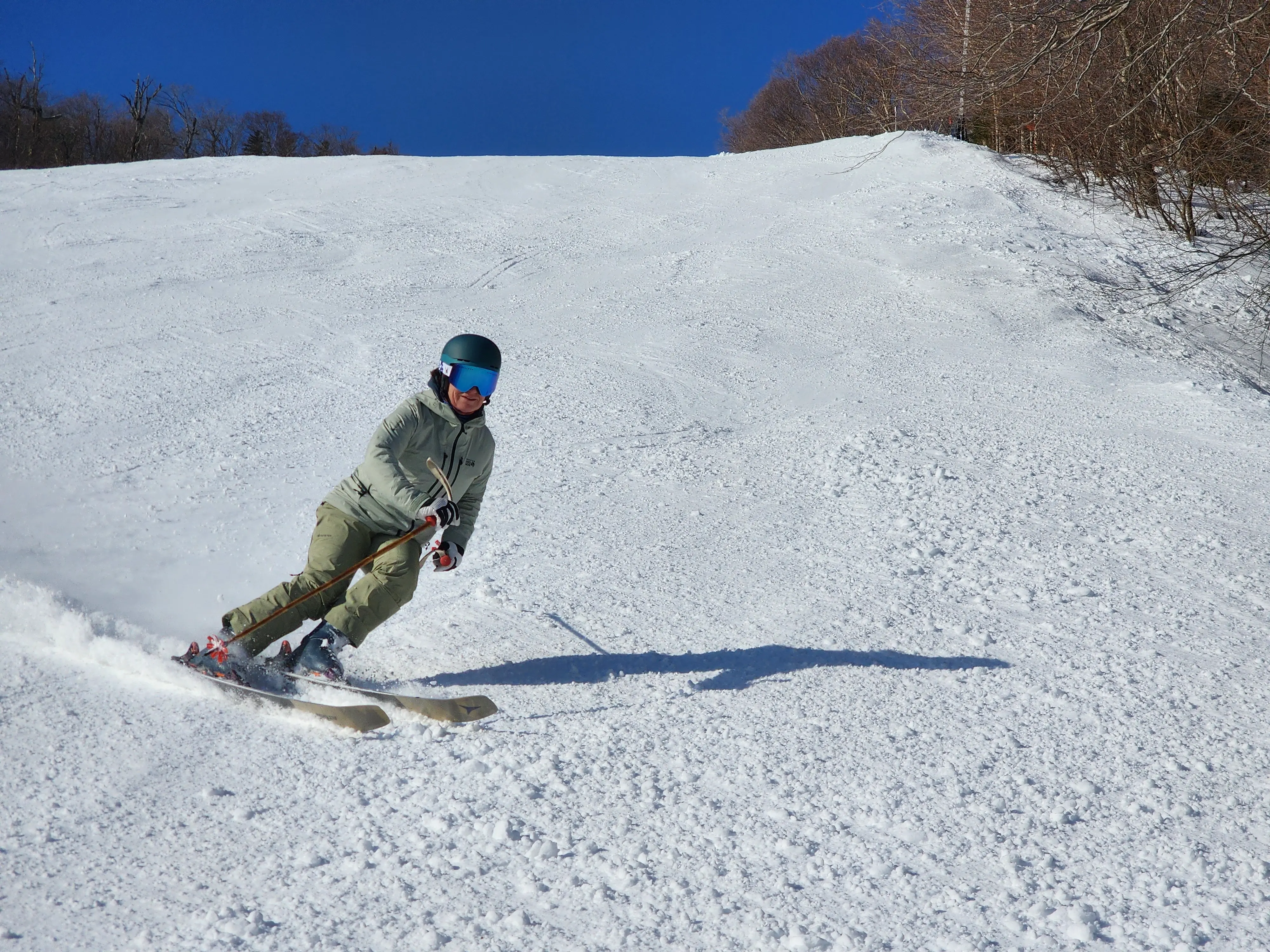



Waist Width
Terrain and snow conditions both dictate the proper waist width of a ski. Measured in millimeters, all-mountain skis come with waist widths that range from the mid-80s underfoot to the low 100s. In general, the narrower the waist of a ski, the easier it is to carve, especially in harder snow conditions. A good example is the Black Pearl 88.
In contrast, a wider ski can be more difficult to get on edge in firm conditions. That said, there can be benefits to a wider ski, like Line’s Pandora 106, even in hard-packed conditions. Wider skis are often more stable in variable terrain and snow conditions. In soft snow and deep powder, more surface area translates to more floatation.
“To find the sweet spot, you need to factor in what type of terrain you ski in, as well as what feels good,” said Preston Case, DPS Product Line Manager for Skis. “At DPS, we consider the surface area of the ski, not just the waist width in determining what a skier can expect.” Case also mentioned that many brands have online tools that can help determine which ski is right for you.
Many ski models are available in various waist widths. If you like a specific ski and lean toward a certain type of terrain, be sure to select the best waist width for you. For every ski in this guide, we’ve listed the available waist widths. For most snow climates, we’d recommend something in the 85 to 105 mm underfoot range for an intermediate to advanced skier.
Ski Length
Ski length is an important consideration, and all skis are available in multiple lengths.
A skier’s size, skill, and aspirations determine the appropriate ski length. Shorter skis are easier to handle and maneuver, which often makes them a better choice for beginners. Longer skis often float better in powder, they’re faster, and they’re usually best suited to advanced skiers. A skier’s weight can impact a ski’s flex, maneuverability, and power transfer. And terrain can influence what ski length is right for you.
Even if you’re an expert skier, if you ski a lot of tight East Coast trees, you might want a shorter ski than if you only ski wide-open groomers and powdery bowls. Check each manufacturer’s recommendations and chat with your local sho’s ski and ride expert to find the right ski and ski size for you. Volkl’s Secret and Elan’s Ripstick both have exceptional size ranges.
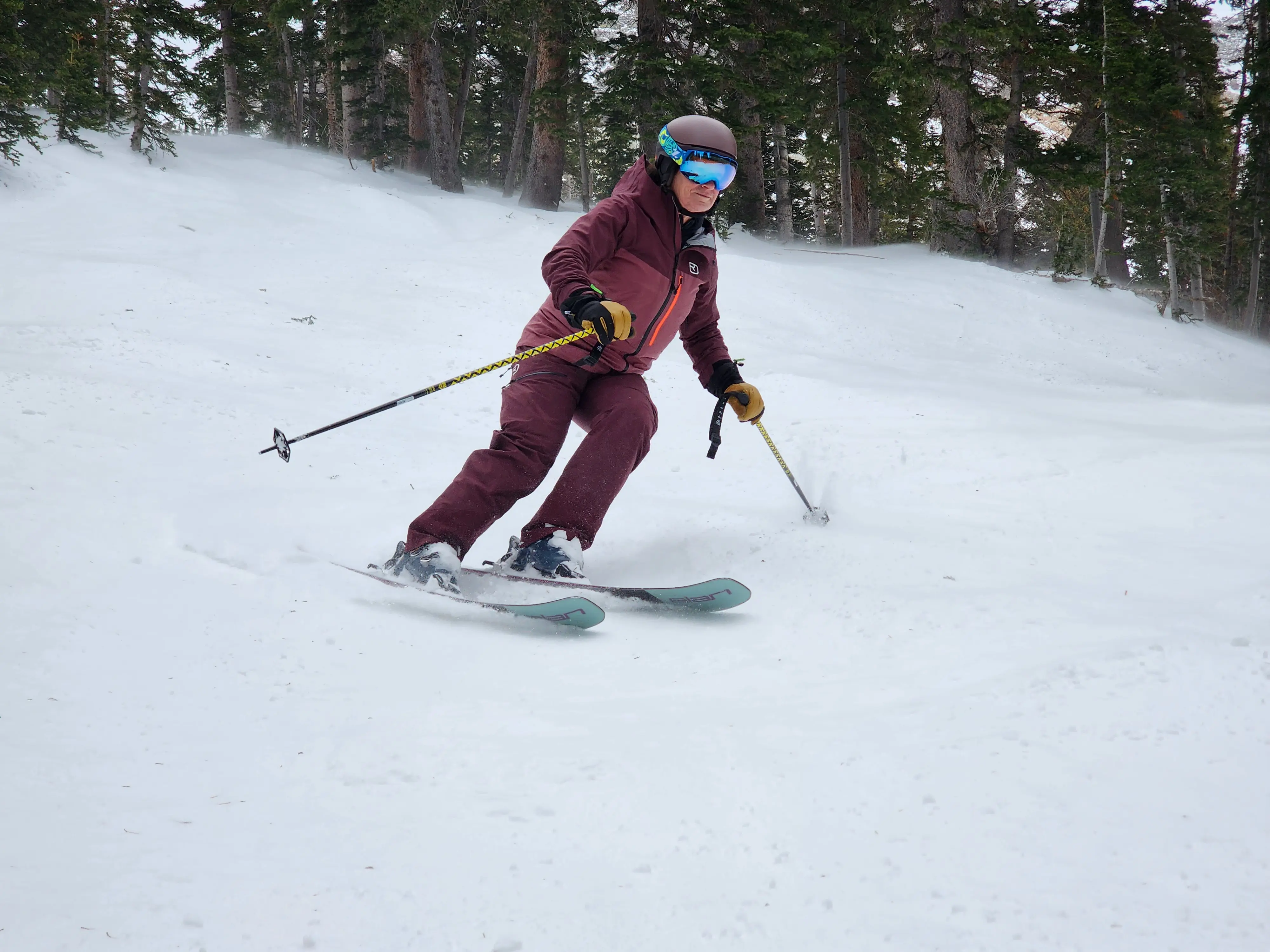



Ski Profile: Camber, Rocker, Early Rise
A ski’s profile impacts its overall performance. Today, the market is full of skis with all kinds of different profiles, from traditional to experimental and everything in between.
Before we dive into how they ski, here are some terms you should understand.
- Camber is a slight convex bend to the ski. Camber is always underfoot. And it’s what springs you from one turn to the next, which makes skis the Black Pearl 88 so fun to ski. That arch flexes against the snow when you weight the ski to make a turn. It then returns to its convex shape when you release the turn giving you the poppy-feeling energy to carve into the next turn.
- Rocker is the gentle curve away from the snow in the tips and tails of a ski. It gives you float and keeps your tips up; the Elan Ripstick 100 W has more rocker for added float and control. “A small amount of rocker can help pull you through the turn and keep you above the snow,” says Case. “Rocker is the float you feel when snow conditions are variable, chunky, deep. A ski with too much rocker for the conditions will be chattery. A ski without rocker won’t be as compliant in the front of the ski and may feel like it wants to dive.
- Early rise is different from rocker. When a ski has an early rise tip, the front of the ski lifts visibly off the snow, like in the Black Diamond Impulse Ti 104. It’s easiest to see on hardpacked snow and most useful to have when you’re skiing powder. However, there are times when early rise can help a skier plow through chunky or heavy snow. Early rise gives a ski float in a turn, and it keeps edge initiation through the full arc of turn regardless of snow conditions.
How Rocker and Camber Impact Skiing
Skis with a more traditional camber profile are shaped like a gentle arch and rise up underneath the foot, making contact with the ground at the tip and the tail. While skiing, your body weight pushes the base of the ski against the snow. For pure carving purposes, traditional camber is still the leading ski profile, and many skis on this list feature some variation on the traditional camber shape.
Traditionally cambered skis tend to be rockered or flat in the tip and tail.
A handful of skis feature a reverse camber design, which looks like a banana. That shape is more inclined to slide turns than to carve them, but reverse camber skis can be a ton of fun in soft, deep snow.
Many of the best all-mountain skis have a rocker-camber-rocker profile, including twin tips, like K2’s Reckoner. To learn more about ski profiles and the complex differences between them, check out this handy video from snowsports retailer Evo.
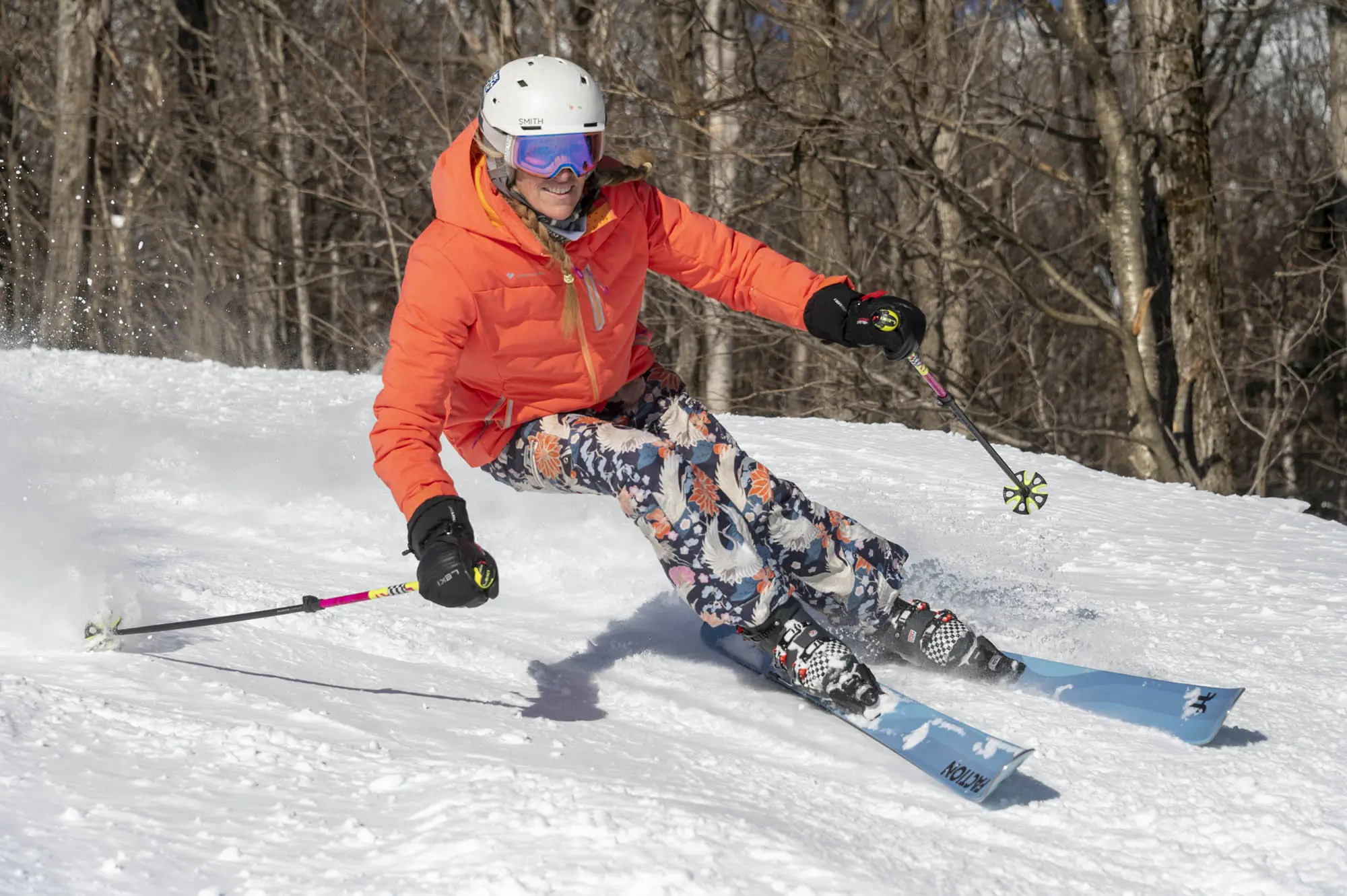



Flex and Stiffness
How stiff your ski is will determine how it feels on snow. Soft and flexible skis are easier to maneuver. They’re more playful and better suited for beginner to intermediate skiers. Park and pipe skiers who love to hit boxes and rails may also want a relatively soft and flexible ski, like K2’s Reckoner or Faction’s Dancer 2. A downside of a soft ski is that it’s prone to chatter at high speeds and feels harder to control. Soft skis don’t always grip well in hard-packed conditions.
Advanced and expert skiers who like to ski fast and carve hard often prefer stiffer skis. Stiffer skis usually use metal in their construction. A stiff ski requires power and good technique to ski well. Volkl’s Secret is one of the stiffer women’s skis made.
Most all-mountain skis fall somewhere in the middle of the soft-to-stiff spectrum. Groomer-leaning skis are usually on the stiffer side to best support speed and stability. Powder-leaning skis are more flexible to maximize surfability and playfulness. If you’re looking for pure versatility, midrange flex is the way to go. Many of the best skis are stiff underfoot and more forgiving in the tip and tail.
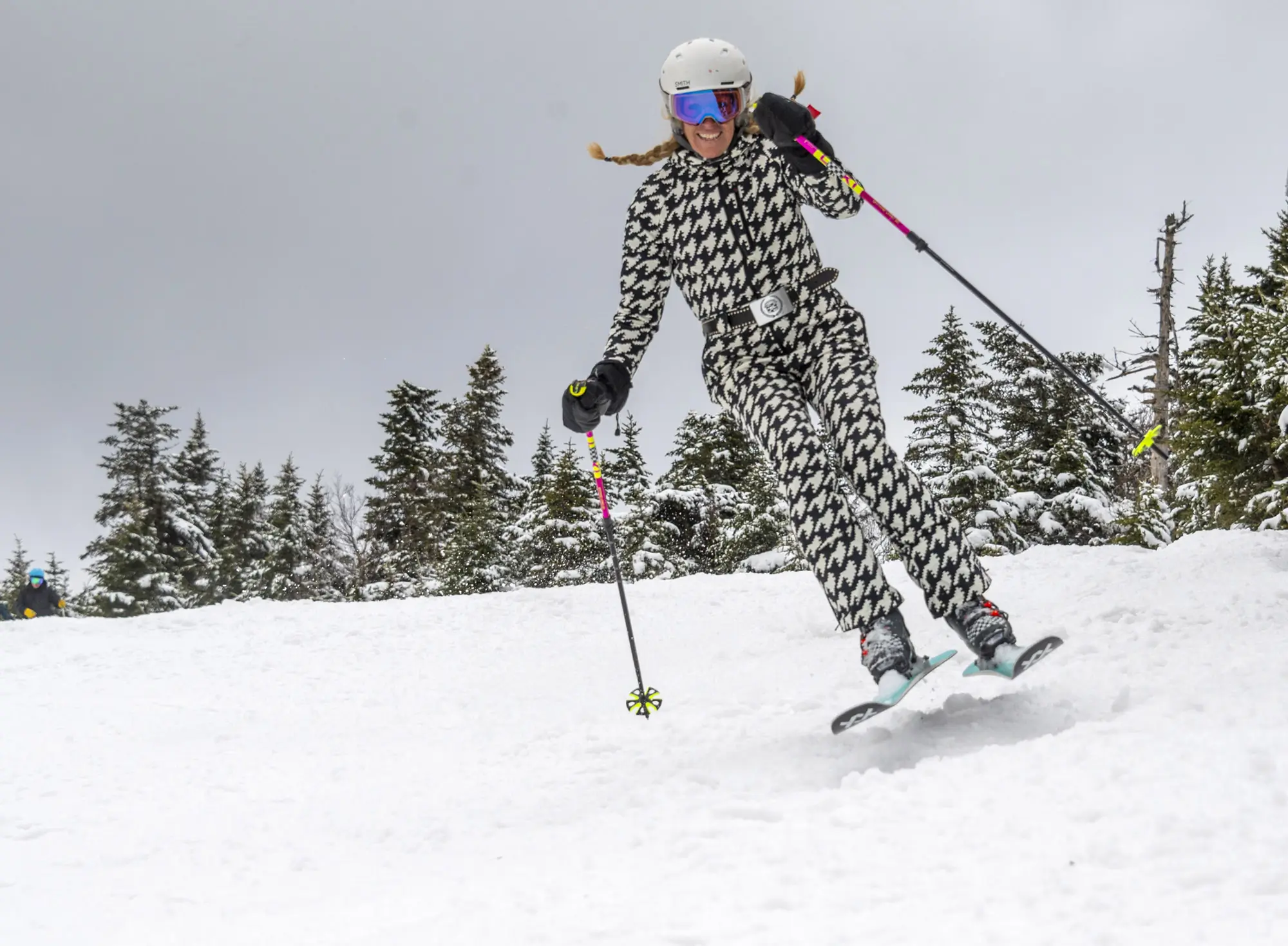



Turn Radius and Sidecut
The sidecut of a ski, also known as its turn radius, refers to the shape of the curve along either side of its length. To some degree, all skis have an hourglass shape, but the radius of these curves has a crucial effect on steering, speed, and stability.
Short Turn Radius
Skis significantly wider at the tip and tail than in the waist will have a short turning radius. A shorter turning radius is great for quick and nimble movements in the trees and moguls. Anything less than 16 m has a short turning radius. Elan Ripstick 100 W and the K2 Reckoner both have a short turn radius.
Long Turn Radius
Anything over 20 m has a long turning radius. Skiers who ride fast and carve hard in wide-open bowls and groomers prefer skis with a longer turning radius. While a long turning radius can make small, quicker turns more difficult, a ski with a long turning radius may have better edge hold and stability when laying down fast, GS-style turns.
Other Types
Some skis land right in the middle and give you the best of both worlds, like the Black Diamond Impulse.
Some brands are now building multiple-turn radii into one ski to enhance their versatility, like the Volkl Secret 96. This highlights that while a ski’s sidecut does partially define its personality, it won’t tell you everything about how a ski will actually feel on the mountain. Other factors — including flex and profile — combine with the shape of the sidecut to define the performance personality of any given ski. The sidecut often changes according to a ski’s length, and some skis are way more versatile than their sidecut on paper suggests.
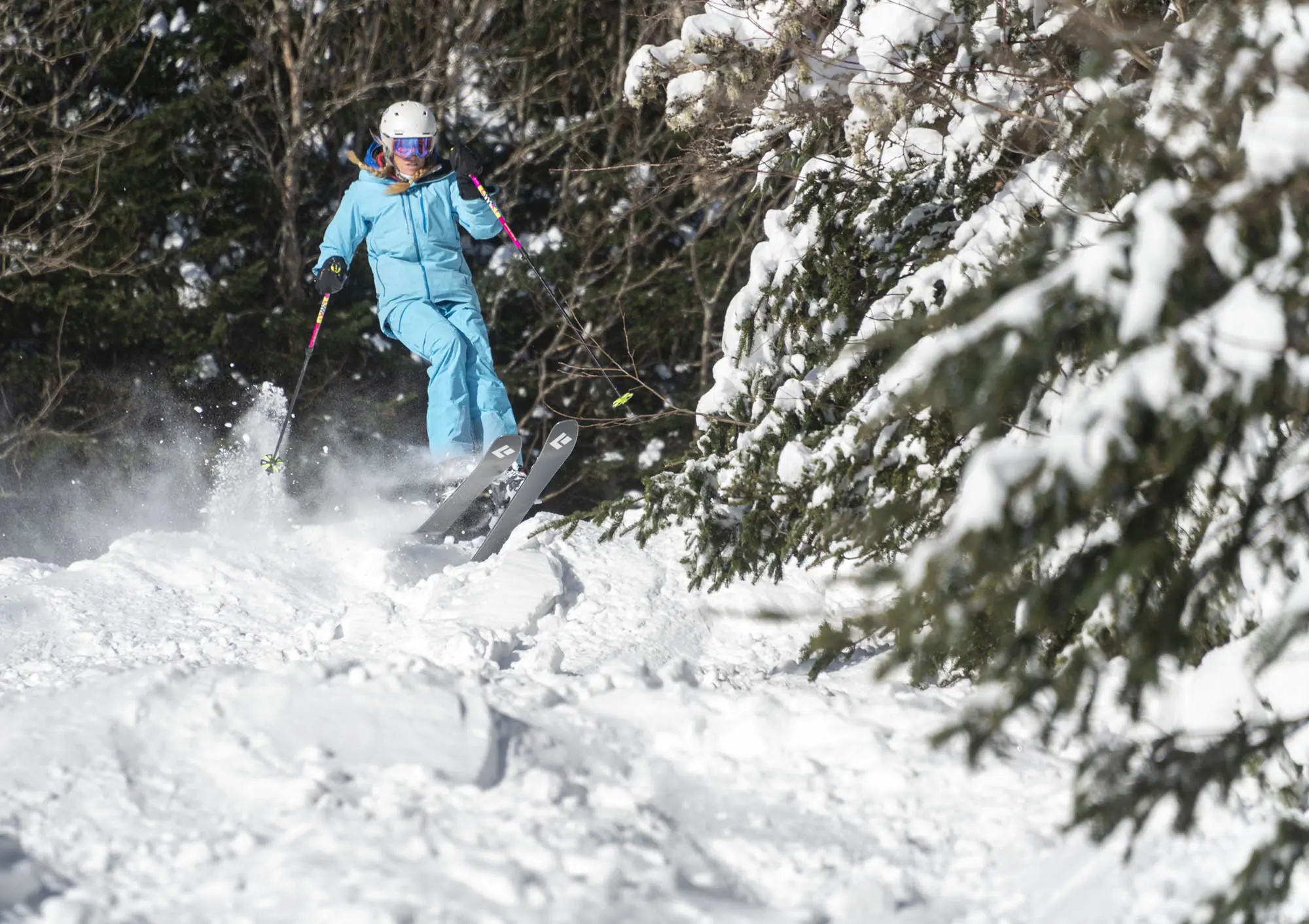



Parts of a Ski
All skis have laminates, sidewalls, core, base, and edges.
Core and Laminates
The core of a ski is the innermost material that defines the ski’s basic structure, shape, and flex. Most all-mountain skis use a wood core made from aspen, poplar, beech, or a combination. You will commonly find foam cores in cheaper, beginner-level skis.
Around the core, brands add carbon fiber, metal, fiberglass, and other materials to give a ski pop, rigidity, and dampness.
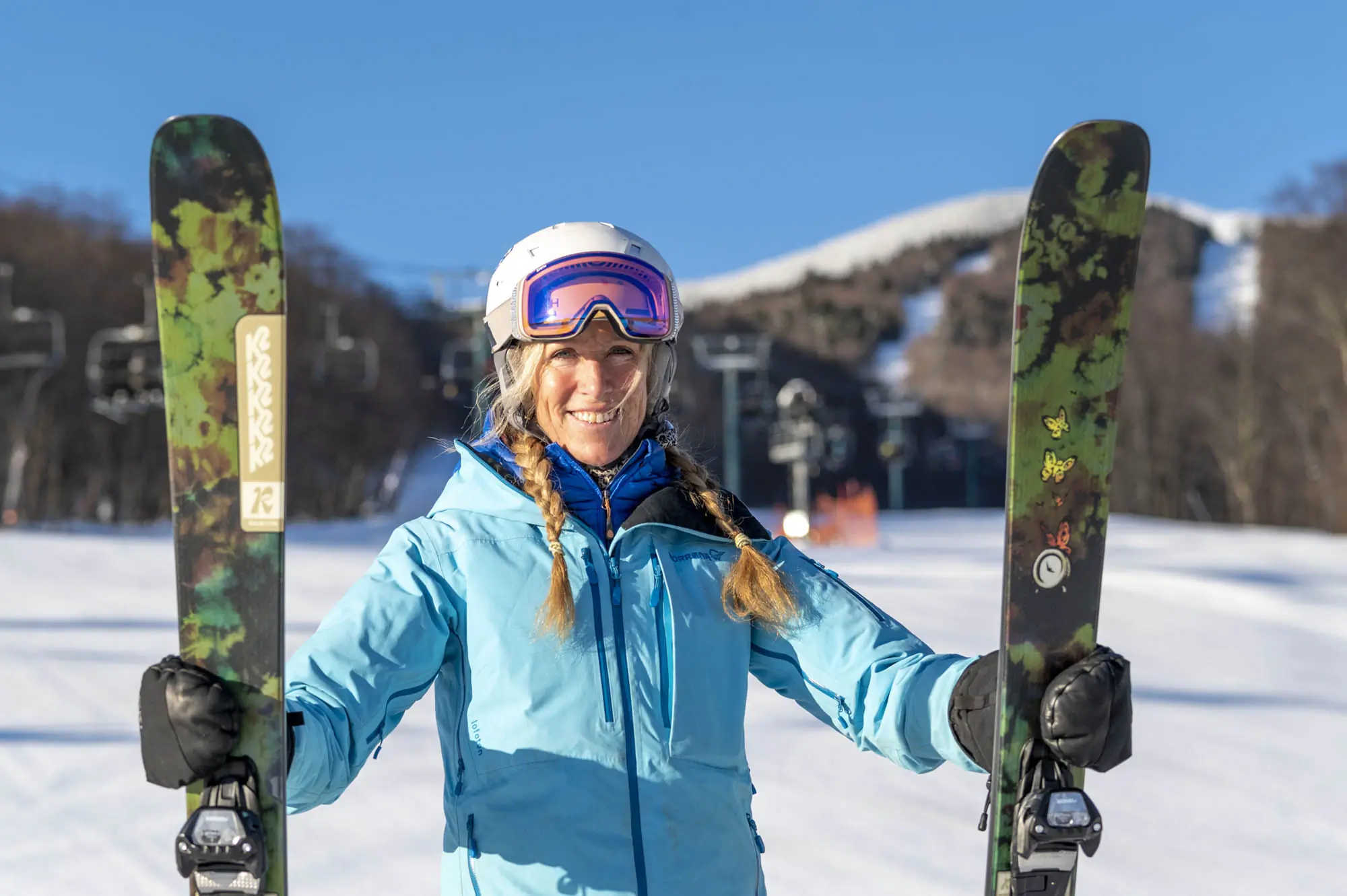



Base
A ski’s base is the surface that comes in direct contact with the snow. Bases are either extruded or sintered.
Generally, beginner skis have extruded bases because they’re more affordable and they’re low maintenance.
Sintered bases are the norm for almost all skis on the market. Though these bases require regular waxing and general maintenance, they’re the best option for consistent all-mountain performance. Consider treating yours with Phantom Glide. This is a permanent waxless base treatment that makes your skis feel like they were recently waxed.
Sidewalls
The sidewalls are the material along the perimeter of a ski. Sidewalls are generally made from plastic that protects the sandwiched core layers. Sometimes, fiberglass and the ski’s top sheet extend to cover the sidewalls. That’s called capped construction. The sidewalls can also use a hybrid construction.
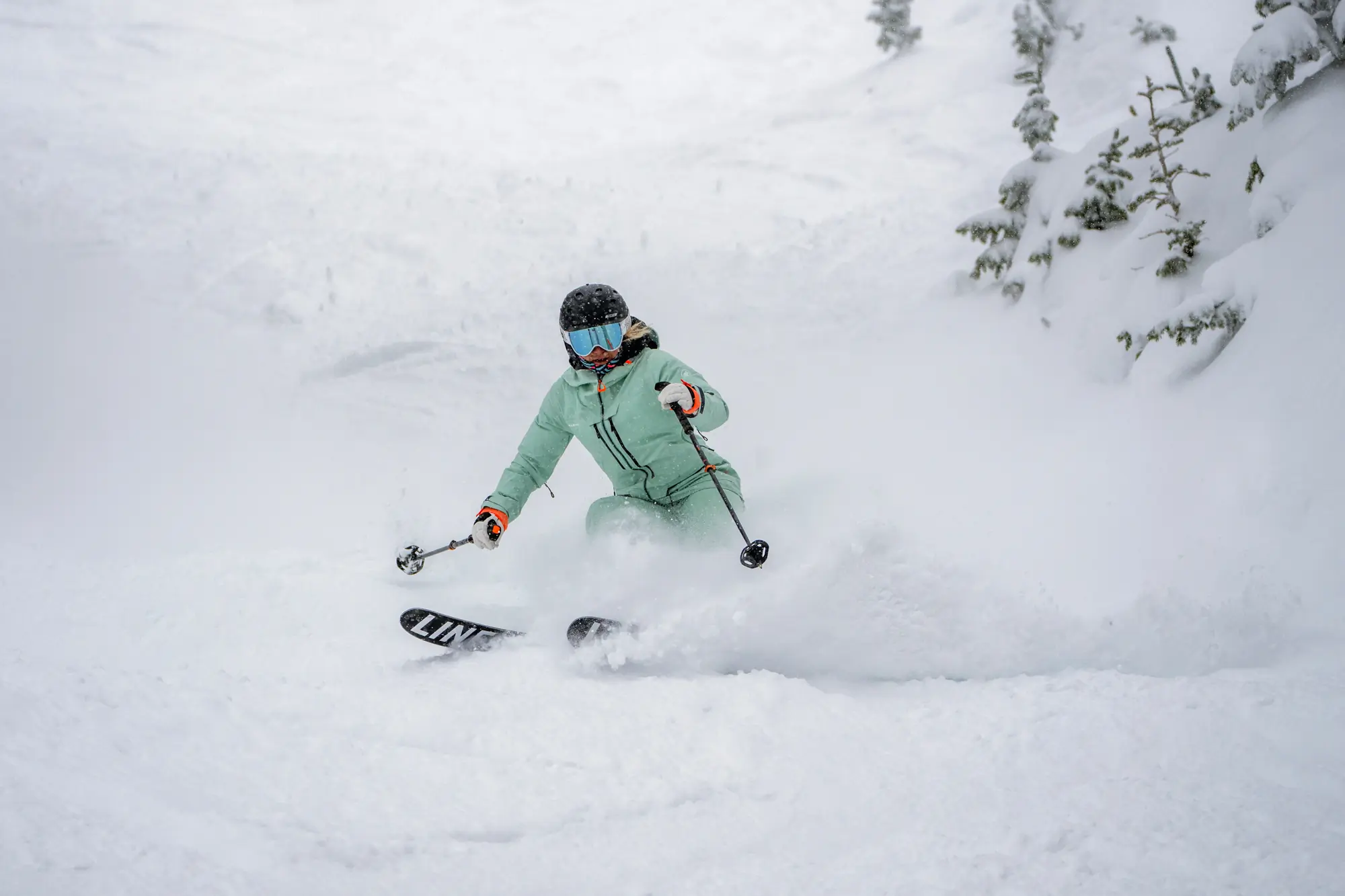



Women’s Skis vs. Men’s Skis
Whether you ski a women’s ski or a men’s or unisex ski is a personal preference. In many cases, men’s and women’s models are the same with different lengths available and alternate graphics. Volkl’s Secret and Mantra are the same. So are Elan’s Ripstick 100 W, and Black Diamond’s Impulse Ti W and Impulse Ti. Some skis are truly designed for and by women, like Blizzard’s Black Pearl and Sheeva.
When women’s skis are distinct, they’re often lighter and softer. They can sometimes have a slightly setback mounting point.
And ultimately, a ski doesn’t know or care what gender you are. Prioritize performance over whether the ski is labeled men’s or women’s. Even though skis may not be designed specifically for women, we loved how some unisex versions perform.
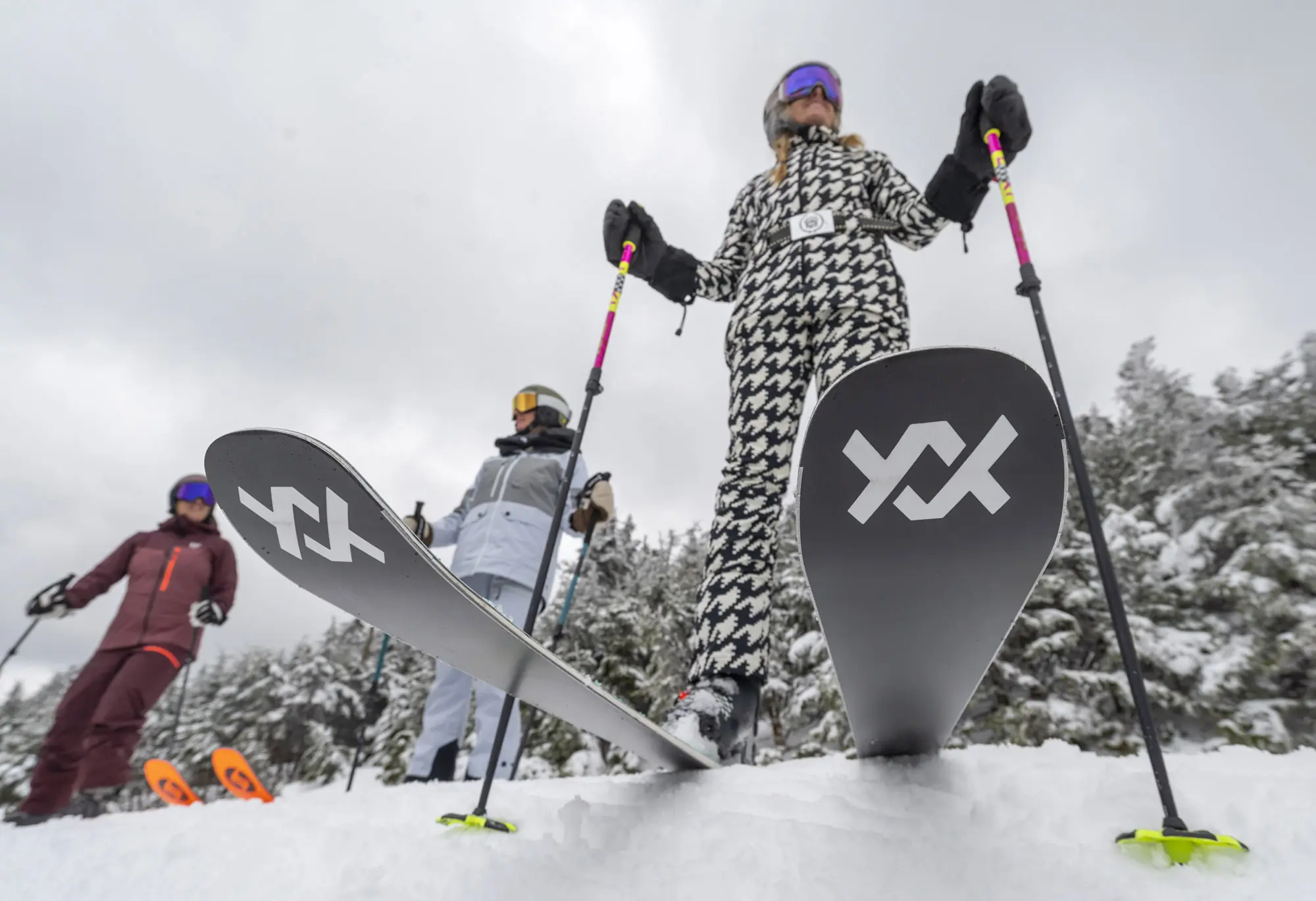



A Note on Bindings & Boots
Without good boots and bindings, the best ski won’t perform. Skis, boots, and bindings work together to make your day on the slopes great.
Most boots and bindings can be successfully mounted to most skis, regardless of brand. Some manufacturers and websites (like Evo and Backcountry) allow you to purchase a ski premounted and paired with bindings.
Types of Bindings
As with skis, there is an overwhelming range of choices for ski bindings on the market. Bindings are generally defined by their DIN rating, weight, and construction. To choose the best one for you, you’ll have to determine a few factors. Consider your ski width, how aggressively you ski, and if you’ll spend any time ski touring in the backcountry.
Alpine Bindings
We generally prefer an alpine binding for skiing on the resort, which will have a DIN-certified heel and toe piece. DIN, or release value, is important because releasing from your bindings at the proper moment is essential for preventing injuries on the slopes. Choose a binding with a DIN to match your level. The lower the DIN, the less force required to eject from your skis.
More experienced and aggressive skiers will want to look for bindings capable of a higher DIN setting. We recommend having your DIN adjusted and set by a professional to prevent injuries associated with unintentional release or failure to release. A certified ski technician will set your DIN based on your ability, weight, and height.
Backcountry-Specific Bindings
If you want to ski in the side country or backcountry, you’ll need an alpine touring (AT) capable binding. These systems generally must integrate with your boot, usually by inserting pins into holes in the front of the boot to allow for a pivot that enables walking uphill.
Bindings for backcountry touring come in a spectrum of styles. Hybrid-style bindings, like the Salomon Shift, have pins for uphill movement but transition to a more traditional binding style for downhill. Traditional AT bindings attach the boot to the binding with pins. To find the best touring binding for your needs, check out our guide to the best backcountry bindings.
Ski Boot and Binding Compatibility
When considering an all-mountain ski, it’s essential to confirm that your boots can interface properly with your bindings without releasing. If you’re planning on skiing backcountry boots in bounds with a DIN-certified binding, you’ll need to ensure that your boots work with the toe ledge of the binding in downhill mode.
Some backcountry-specific boots, especially those with fully rockered soles or without a toe ledge, like the Dynafit Hoji, will not work with those bindings. Additionally, many backcountry-specific boots will not work properly with a resort-specific binding. Ask your local ski shop if your boots and bindings will work together, and be sure to do your research before committing to a particular combination.
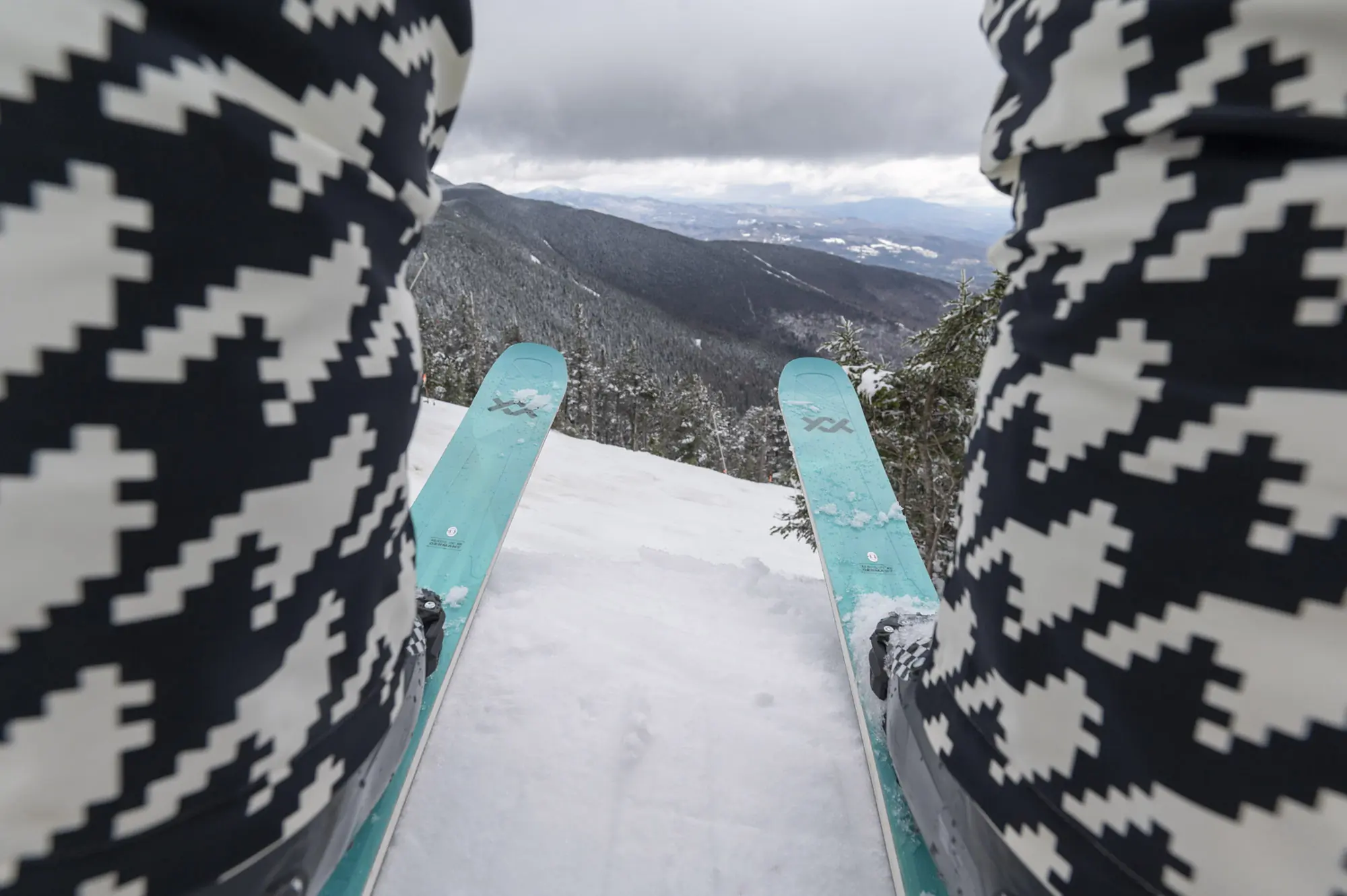



Sustainability
While building skis hasn’t traditionally been eco-conscious and environmentally friendly, many brands, including Atomic, Elan, and Blizzard, are recognizing the impact of global warming on their sport and striving to be more sustainable. Atomic operates in a factory that uses 100% renewable energy. Brands are using plant-based resins instead of petroleum-based resins. At GearJunkie, we’re always keeping an eye out for sustainable innovations in ski gear. Check out our article on how to makeover your ski gear to be more eco-friendly.
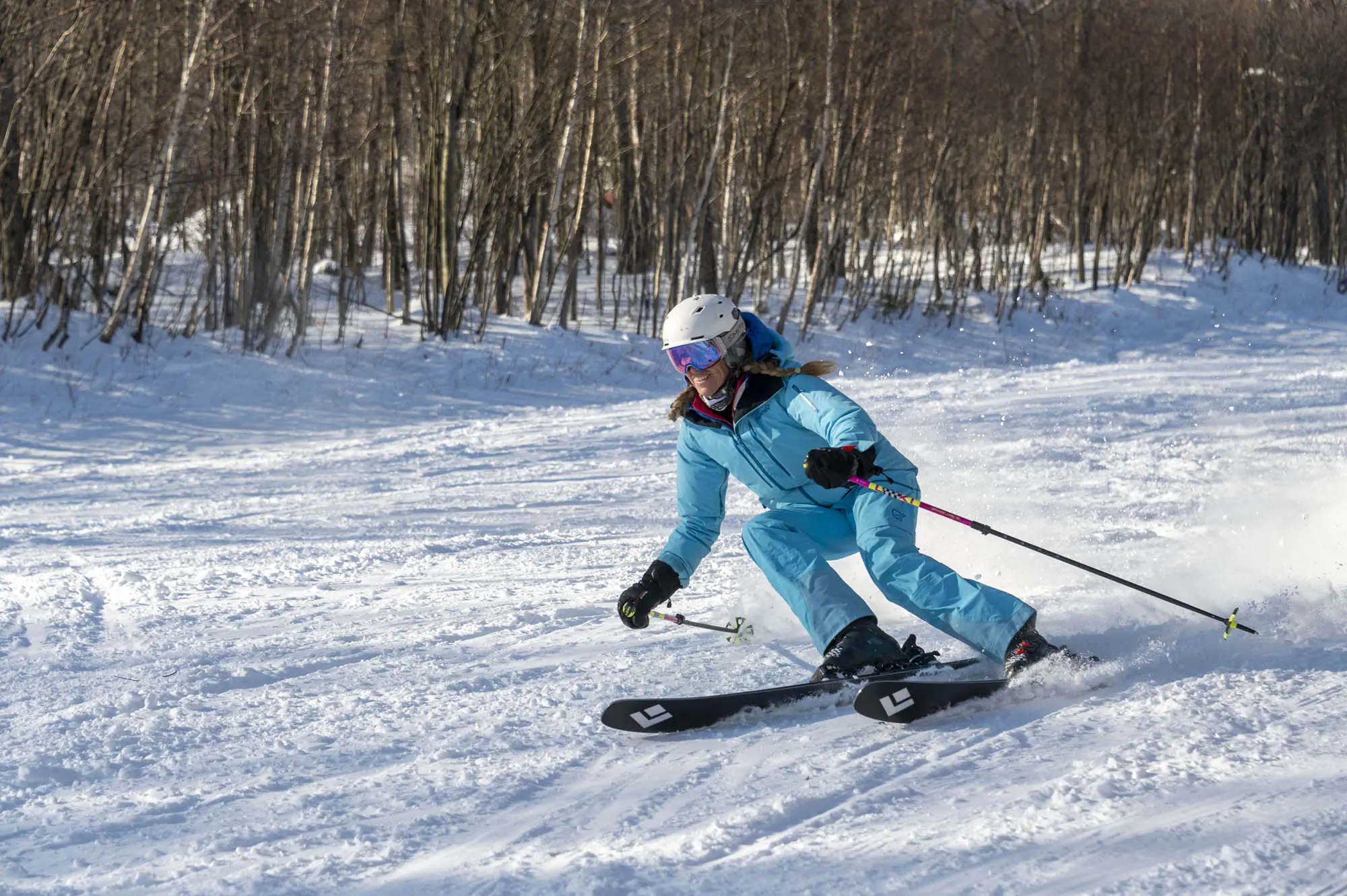



Price & Value
For most of us shopping for skis, price is a consideration. You’ll pay more for skis that are made in the U.S., and for ingredients inside the ski, like carbon fiber. Sometimes, cost is more marketing than anything else. Some brands position themselves in a price bracket to appeal to a certain set of customers. For example, historically, K2 and Line skis are some of the most affordable. DPS skis are all over $1,000 unless you find a killer sale or buy them used.
Unlike many product categories, when it comes to skis, you can find great options in most price categories. The budget skis that we recommend in this review are great options relative to their price. Just because a ski is more affordable doesn’t mean its a lower-quality ski. But lower-priced skis may not be as versatile as more expensive ones.
All the skis in the review will allow you to have an enjoyable day on the slopes. More experienced skiers and skiers who go faster or tackle more challenging terrain will appreciate Mid-tier or Premium skis that have more advanced materials and engineering and are often more versatile than lower-priced skis.
Budget
Narrower skis — skis under 95mm waist — are frequently $50-100 less than skis that are 103mm or wider underfoot. So, most 95 underfoot skis cost less than skis that are 103 and wider unless those skis use premium materials. Most skis in this category won’t have metal or carbon, which means they won’t hold as well in icy conditions. Most will have traditional camber and flex profiles, they won’t be designed for high-speed skiing. While budget skis are great for dipping your toe into snow sports, they likely won’t help you reach your potential as a skier.
If you’re looking for the cheapest option out there, beginners should consider a system ski, which is a major cost savings because it comes with a binding already installed. Systems skis can cost $500 or less for skis and bindings. Usually bindings add $150-300 and potentially more to a ski setup.
Buy a budget ski, and you may not get the latest and greatest tech, but if you’re buying from a well-established brand, you will get years of trickle-down technology that should be solid. On the flip side, budget skis also may not be as durable as higher-priced skis. They’re typically made for someone who will ski 20 or fewer days each year.
The Line Pandora 106 ($650) is an anomaly in this category. As far as construction and materials, it should fall in the mid-tier range, but Line has kept the price low on this ski, which is worth taking advantage of if it offers the characteristics you want.
Mid-Tier
Almost all of the skis in this guide fit into the mid-tier price category ($651-950). They’re not super cheap or crazy expensive, and like a Swiss army knife, they can handle all conditions on the mountain. In this price category, you can find width options for different skier preferences and a variety of constructions for all types of snow conditions and terrain, as well as skier ability.
In the mid-tier price category, you can find some of everything. Skis with metal and carbon, skis that are more forgiving for skiing the woods, and ones that may have highly engineered underfoot construction for increased performance across the whole mountain. Our most versatile skis, the Elan Ripstick 100 W ($750), are a solid example. So is the Völkl Secret 96 ($850), which has Four Radius Drive and variable radii in different sections of the ski, which gives the skier more control over how the ski turns.
Stepping up to a mid-tier ski from budget skis is beneficial because mid-tier skis generally offer more versatility throughout the range of snow conditions. At the mid-tier price point, manufacturers incorporate more creative rocker and camber profile designs for skiers who are not necessarily looking for a traditional ski.
Premium
Most premium all-mountain skis cost $950 and above, like Atomic’s Maven 103 CTI ($975). Premium skis are often priced higher to attract a more affluent customer or to create the illusion that they’re better than lower-priced skis, which is not always true.
In the premium price category, you get the latest tech and the highest-cost combination of materials that minimize weight and maximize performance. Premium skis often use the best materials available in every aspect of construction. These include pre-preg fiberglass or carbon, the burliest and hardest edges, or the lightest-weight edges, depending on what the ski is made for, and race-quality bases that are more durable and faster. Skis with unique construction techniques, like the Maven’s carbon-titanate blend and multidimensional tip, often fall into this category.
And custom skis always fall into the premium category. Custom skis are made specifically for each customer, from construction to graphics. If you’re a skier who wants nothing more than a photo of your favorite mountain range, your pet, or a meaningful drawing or painting on your ski, and you have a very specific idea of how you want your ski to perform, consider buying custom skis. We have had the opportunity to ski a number of pairs of Wagner Custom skis, and while each pair is unique, we’ve loved all of the Wagners we’ve skied.
Frequently Asked Questions
The best all-mountain skis are the ones that suit your skill level, skiing style, and budget. On this list, we’ve included many top-quality options across a broad range of design characteristics.
Our current top choice for the best overall women’s all-mountain ski is the Atomic Maven CTI 103.
Some all-mountain skis are excellent for beginner skiers. As a beginner, your priorities are progression and comfort. With these needs in mind, we recommend you choose a ski that is reasonably flexible and narrow. Flexible skis are easier to maneuver, and they won’t fight you for control.
Skis in the narrower range (about 85-95 mm in waist width) will be easier to shift from edge to edge. They tend to do better on the groomers where you’ll likely spend most of your time as a new skier. The is one of the best on this list for beginners.
Depending on the quality of your old boots and bindings, it may be worth considering an upgrade in order to get the most out of your new skis. Older bindings can’t be indemnified, which means that they don’t release safely and your shop won’t mount them.
Most all-mountain skis will perform reasonably well in the terrain park. If you’re a pure park skier, we recommend a twin tip. Generally, skis with better-than-average flex and pop are better than stiff and aggressive skis for park riding. The best women’s all-mountain ski that’s also great for park is K2’s Reckoner.
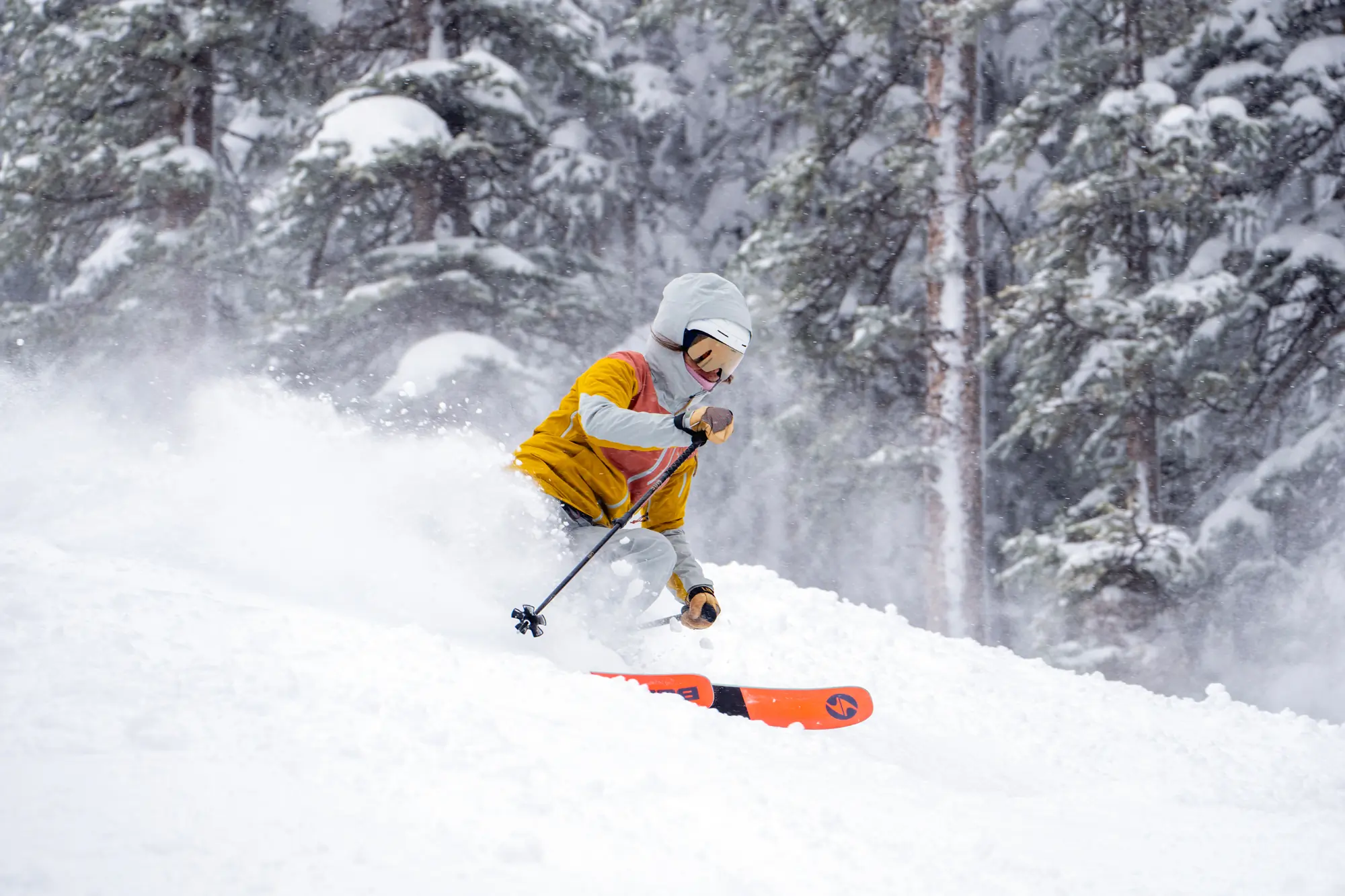



Women’s skis are commonly lighter and more flexible than men’s all-mountain skis. Many brands are moving away from women’s skis to unisex skis, or the make the same ski for men and women, but give women an alternate top sheet and shorter sizes. There are some skis that are made specifically for women from design through build including Icelantic’s Maiden, and Blizzard’s Black Pearl.
All skiers can enjoy both men’s and women’s models. The differences between men’s and women’s models are often subtle, and we recommend prioritizing performance over a men’s or women’s label.
First think about how and where you like to ski. Do you like to ski fast or slow? Do you like groomers, bumps, or trees? Big turns or small ones? Where you ski on the mountain and how much experience you have will determine a starting point for what types of skis to consider. Most skis on the market have a “best for” designation that notes in what terrain the ski thrives, and for what type of skier it’s made.
If you’re an East Coast skier, a narrower ski with good edge hold will be great all-mountain option. If you ski somewhere that sees frequent storms, you might consider a powder-leaning all-mountain ski like Line’s Pandora 106.


With touring-capable boots and bindings, you can use any ski for backcountry skiing. But a lighter ski will be less tiring to ski on uphill. Check out our guide to the best backcountry skis for more touring-specific recommendations.
Although it may seem like a confusing attribute of your new skis to decipher, turning radius — aka sidecut, changes how the ski will feel more than many other aspects of its construction. A ski with a shorter turning radius will be more playful and more maneuverable, which can be better for beginner or intermediate skiers.
A ski with a longer turning radius is best for skiers who like to open the throttle and make large, sweeping GS-turns. Although it provides much more stability at speed, a longer turning radius can also make tree skiing more challenging. Balance your desire for stability and speed with playfulness and maneuverability when choosing a ski.
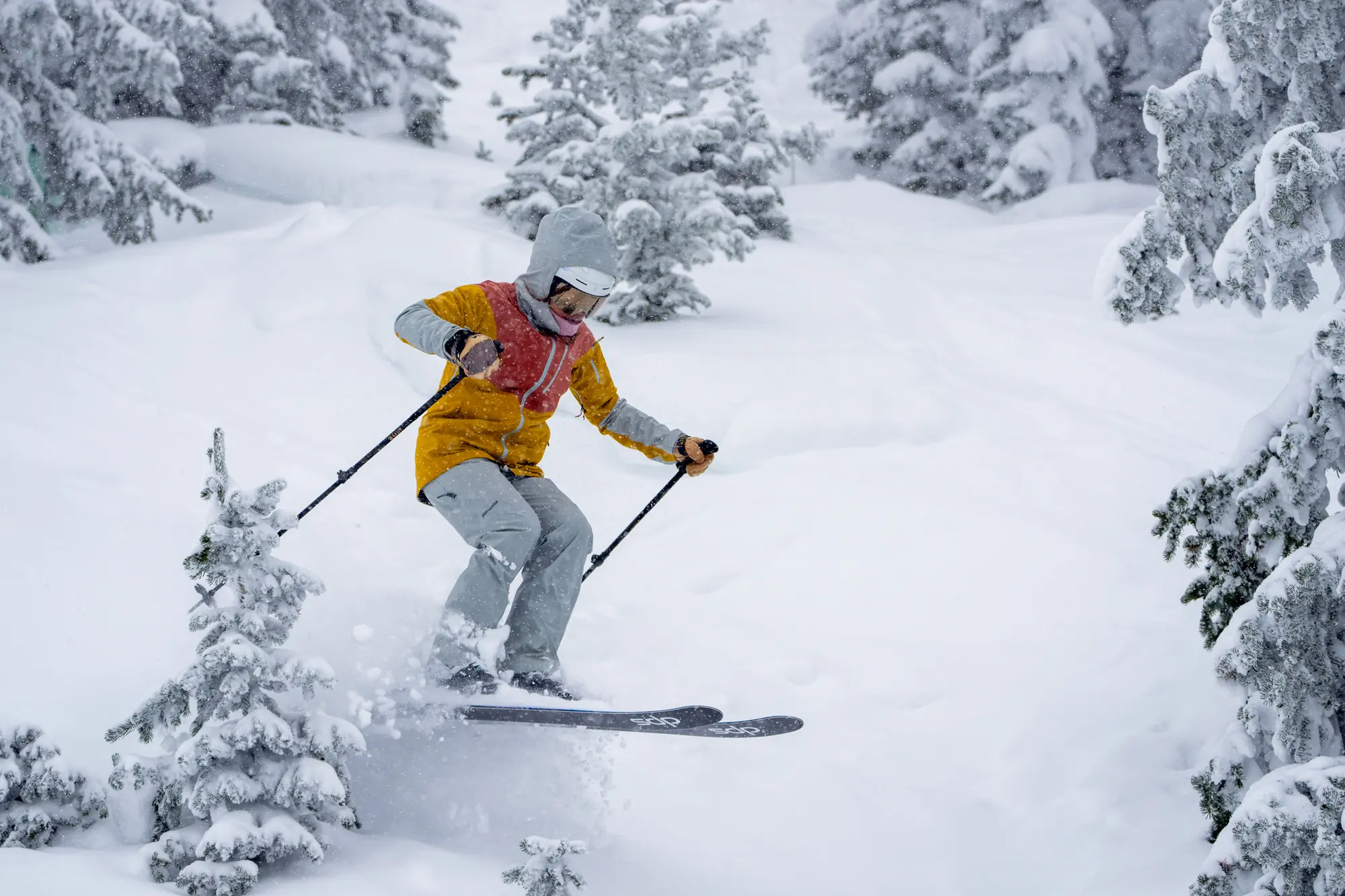





The Best Women’s Ski Bibs of 2025-2026
We hit the slopes to find the best women’s ski bibs. Whether you snowboard or ski at the resort or in the backcountry, we’ve got you covered.


The Best Backcountry Skis of 2025-2026
We tested the best backcountry skis from Atomic, Black Diamond, Salomon, Voile, and more to help you find the best option for your needs and budget.
